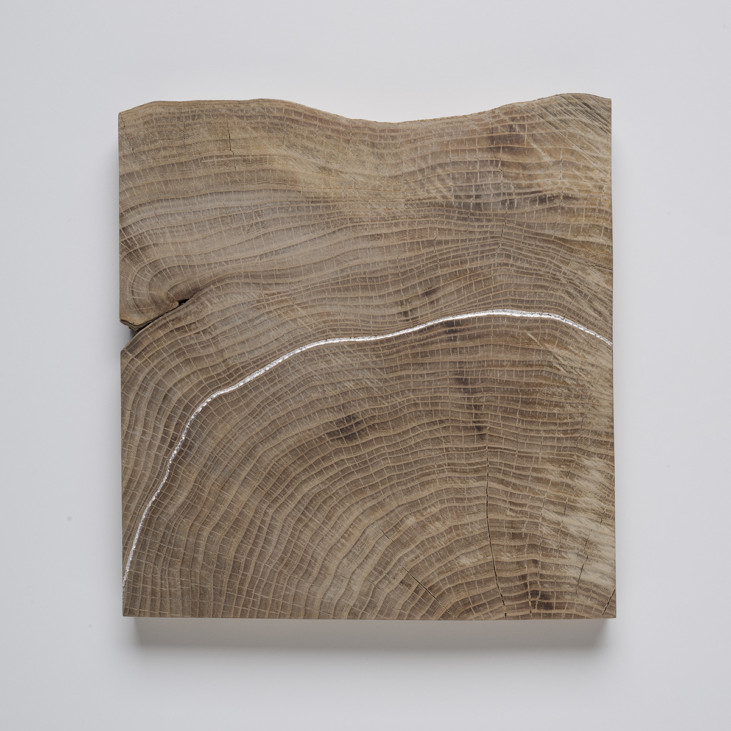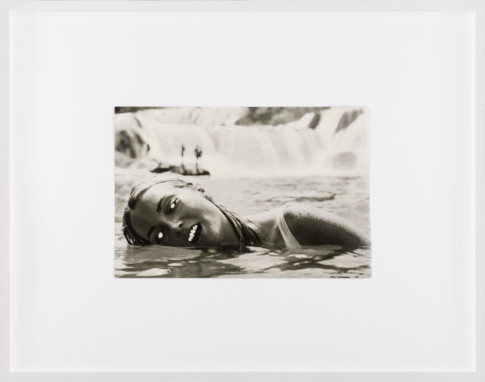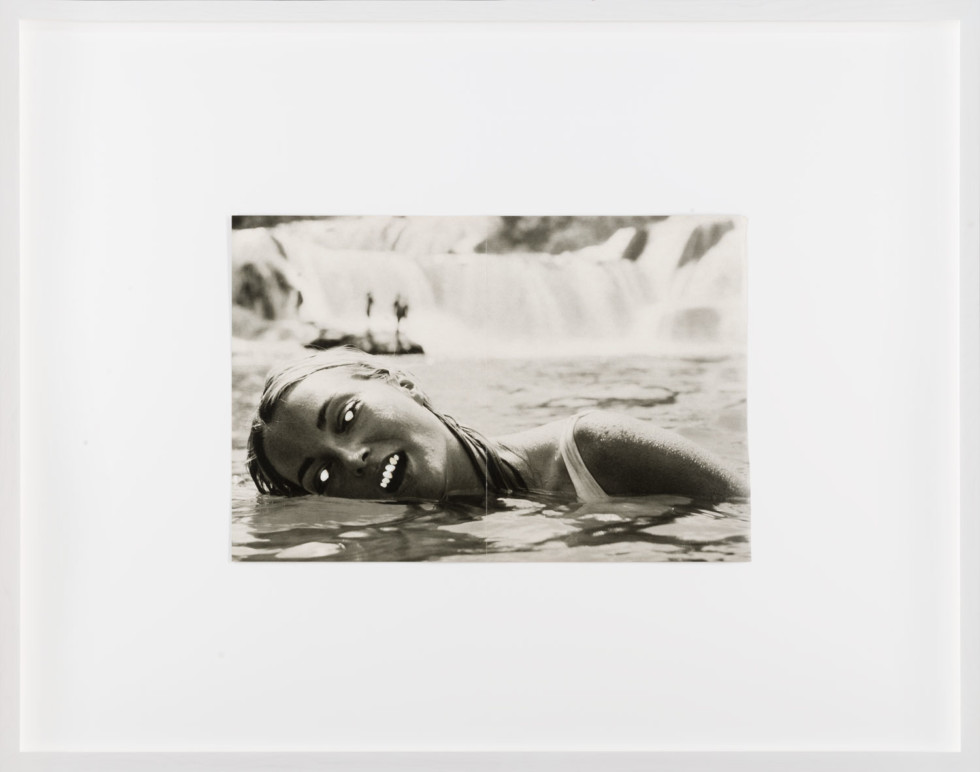
Lotta Antonsson, SEA, 2019 © Lotta Antonsson Photo: Tobias Fischer / Moderna Museet
Participating artists
Adèle Essle Zeiss
Born 1983
“Statolith”, 2018
The performance work Statolith is a balancing act for three people who sit for two hours on boards suspended from the ceiling with concrete sacks taped to them as counterweights. The three separate units are in perpetual motion, both visually and physically. The slightest movement requires a countermovement to maintain equilibrium. The silence and concentration of the dancers in the work sharpens our awareness of both their and our own presence and weight in the room. The human body’s striving for control and stability negotiates the system of weight and counterweight almost unconsciously. These physical functions that operate ceaselessly but beyond our volition fascinate Adèle Essle Zeiss, who is a trained classical ballet dancer.
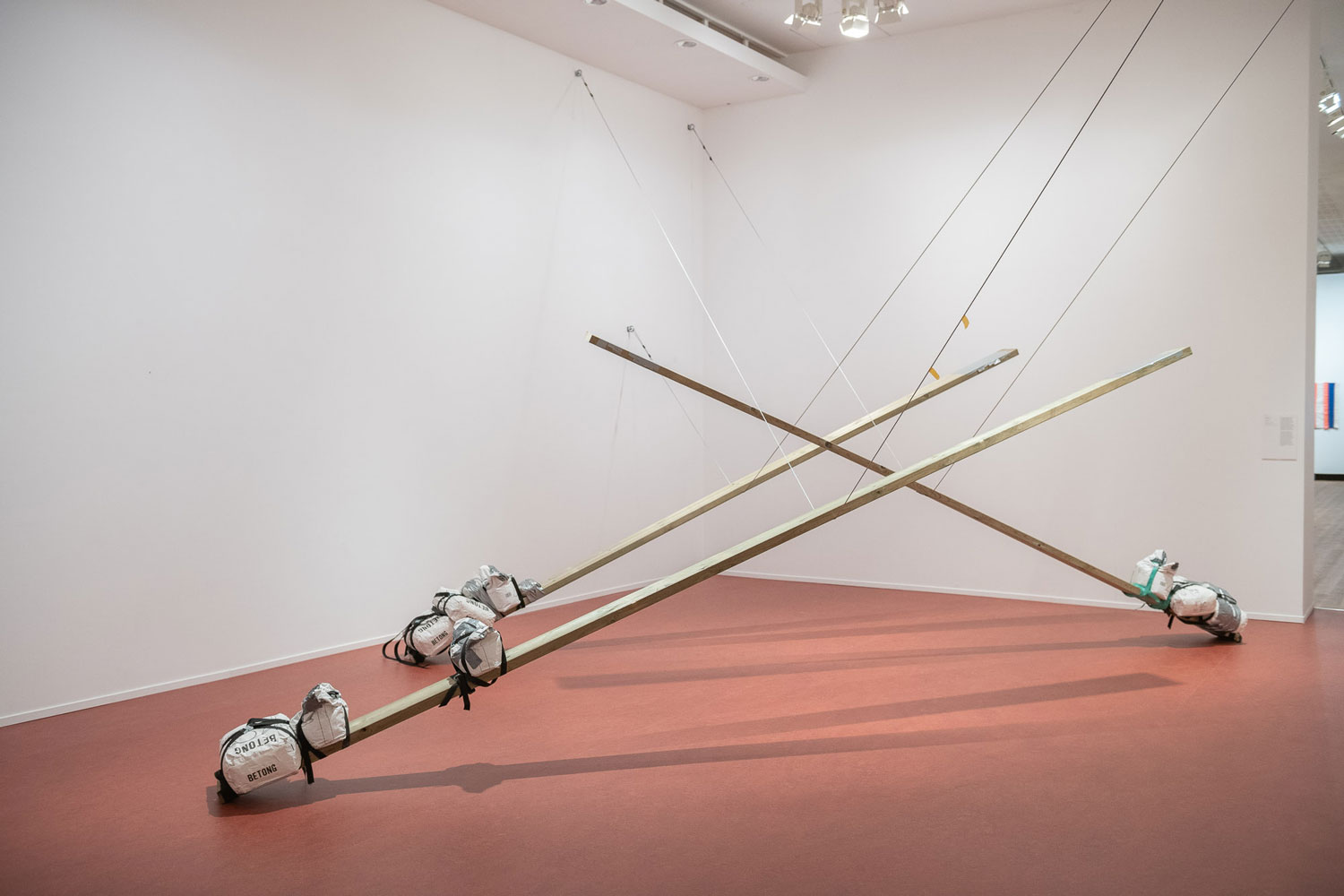
Aleksandra Mir
Born 1967
“First Woman on the Moon”, 1999
The only humans to have landed on the moon are twelve white American men. So Aleksandra Mir came to the conclusion that if a woman ever wanted to walk on the moon, she would probably have to build one herself, and that is precisely what she decided to do. On a one-day action on a Dutch beach, documented by a massive media crew, Aleksandra Mir, 50 volunteers and 10 rented excavators built a moon landscape. There she planted her flag, declared herself “the first woman on the moon” and raised her glass to the audience, which included “the first black man”, “the first gay person” and “the first German” on the pale celestial body.
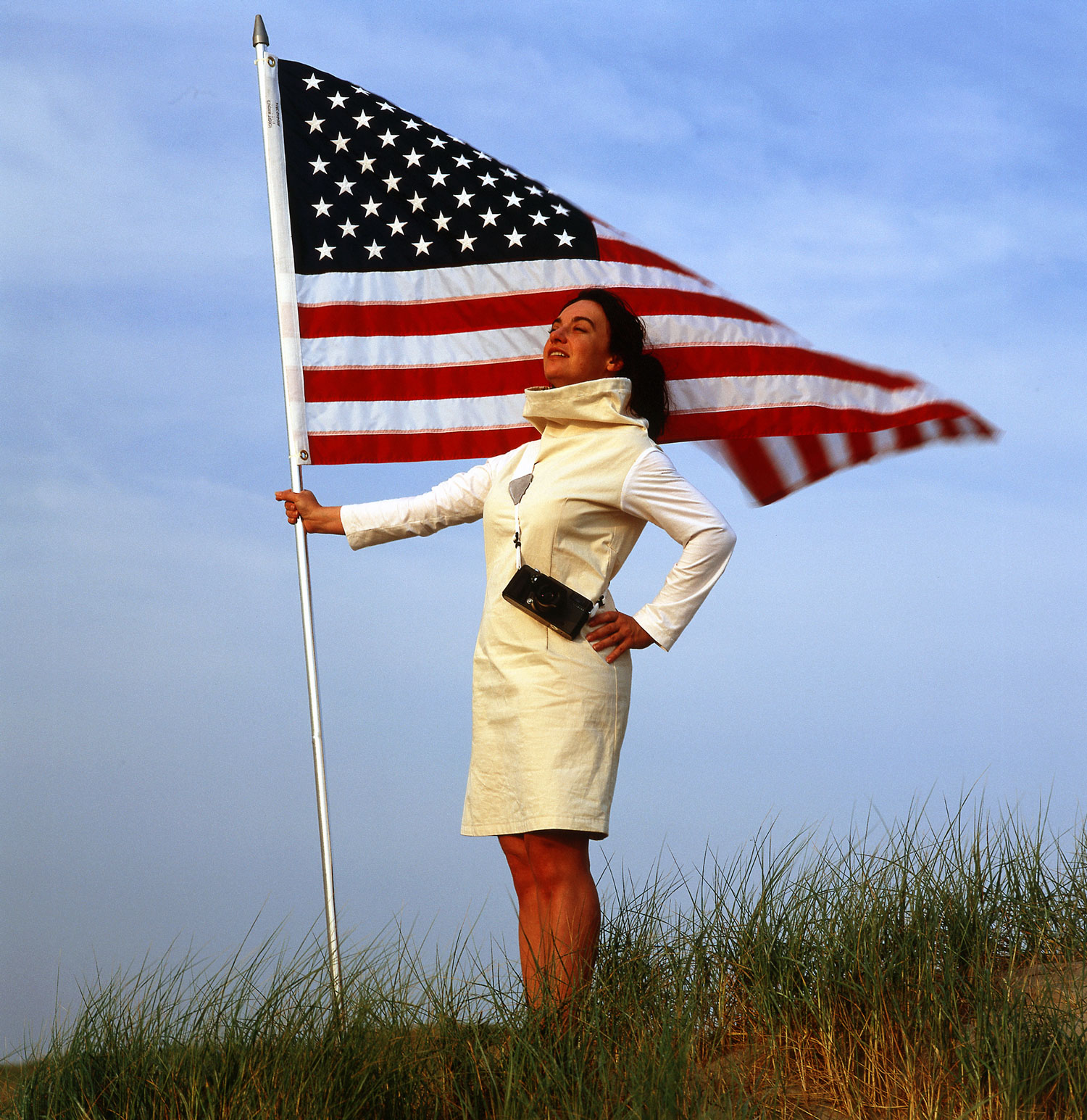
Ami Bergman
Born 1966
“Self-portrait”, 2021
The self fills the pictorial space with ease. The turquoise-blue background is painted with brushstrokes that follow the body, which is dressed in a contrasting light yellow-coloured dress. Ami Bergman’s artistic practice is grounded in years of highly-skilled work using painting and drawing. Often placing herself at the centre, it is as if she repeatedly wants to remind us of something. Bergman’s self-portrait, of herself as an artist, prompt questions of representation, of not pleasing, of defying the limiting norms of how an older woman should look or act. With a paintbrush in her exaggerated hand she meets the viewer’s eye with an exploratory gaze. The hands possess the ability to tirelessly create a place of one’s own in the world.
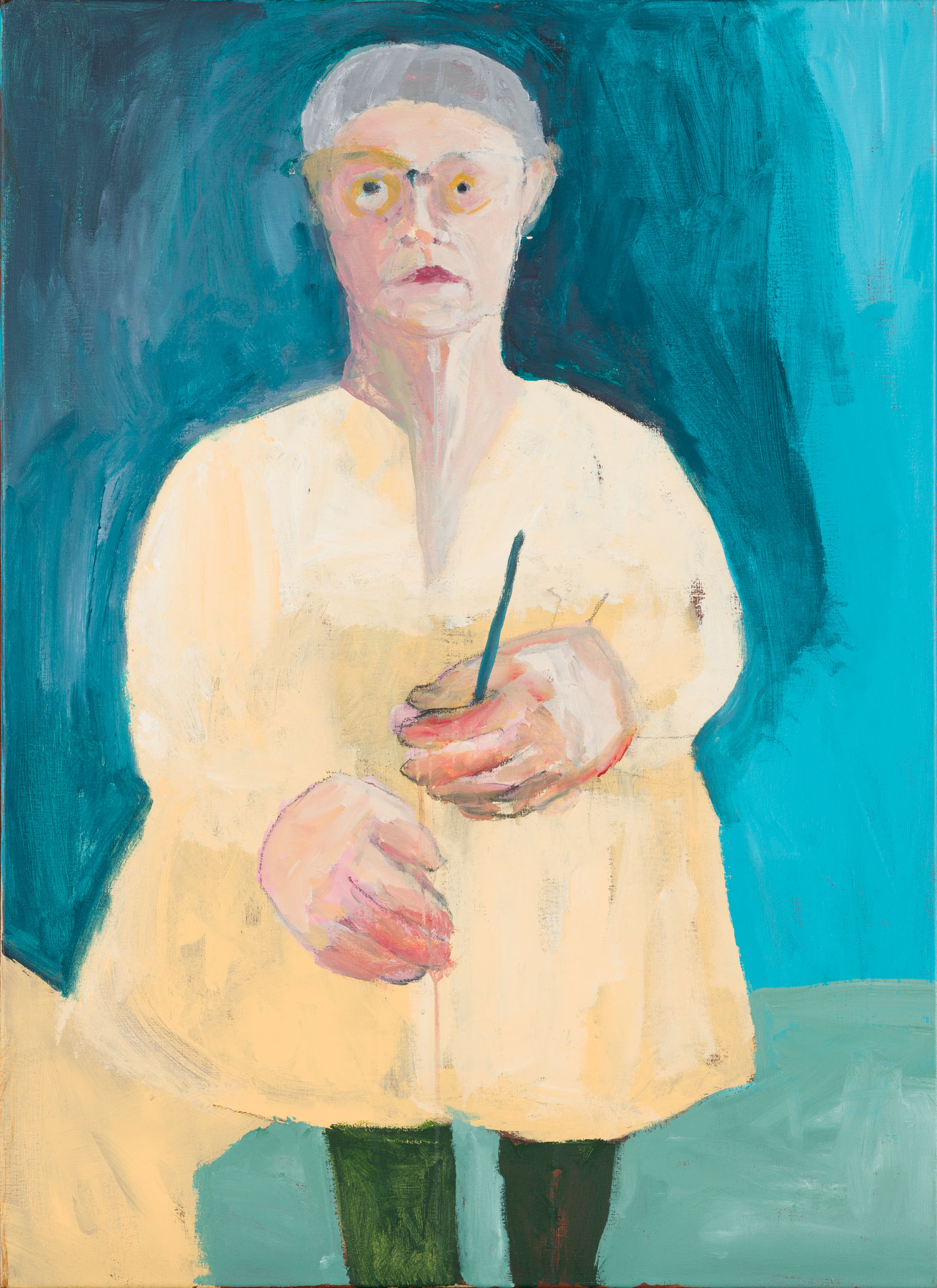
Annika Ström
Born 1964
“The inept five”, 2012–
Having aspirations of a future dream job, whilst being forced to accept another in order to make a living is something many people have experienced. Particularly within the arts. The young people in Annika Ström’s performance are theatre students who have taken on a job of serving drinks at a social gathering. Playing themselves, they wear slightly messy clothes, spill the drinks, and generally act distracted – because they are actually dreaming of being somewhere else. On the real stage. It takes a while before we, the visitors at the exhibition opening, realise that we are witnessing other people’s hopeless dreams, whilst at the same time participating in a performance.
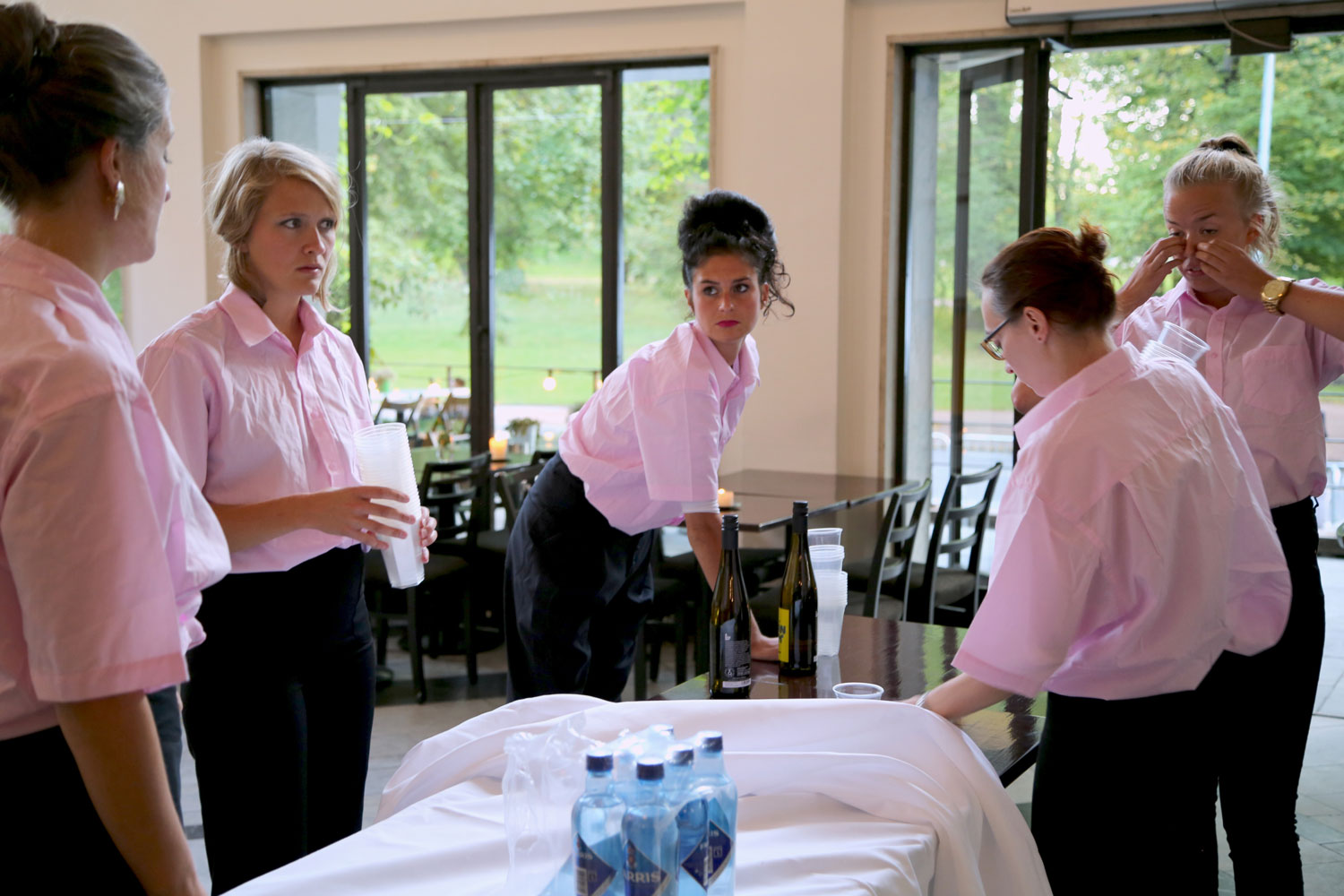
Astrid Kajsa Nylander
Born 1989
“minijobs”, 2020
Sewing on buttons is among the trivial tasks that are usually carried out at home. Despite their insignificance, buttons are actually rather fantastic objects, connecting disparate parts into something congruous. Astrid Kajsa Nylander’s paintings of buttons is titled “minijobs”, emphasising associations to tiny things and trifling feats. The works allude to how women’s practices have been pushed aside historically. One button has shiny, tear-like drops, another has a meticulously-painted insect crawling on it, bringing the image into sharper focus. The American artist Judy Chicago’s feminist colour explosions resound in the irregular canvas shapes of Nylander’s paintings, that expand the boundary between object and painting. There is something physical, vaguely erotic about the thread coiling in and out of the holes.
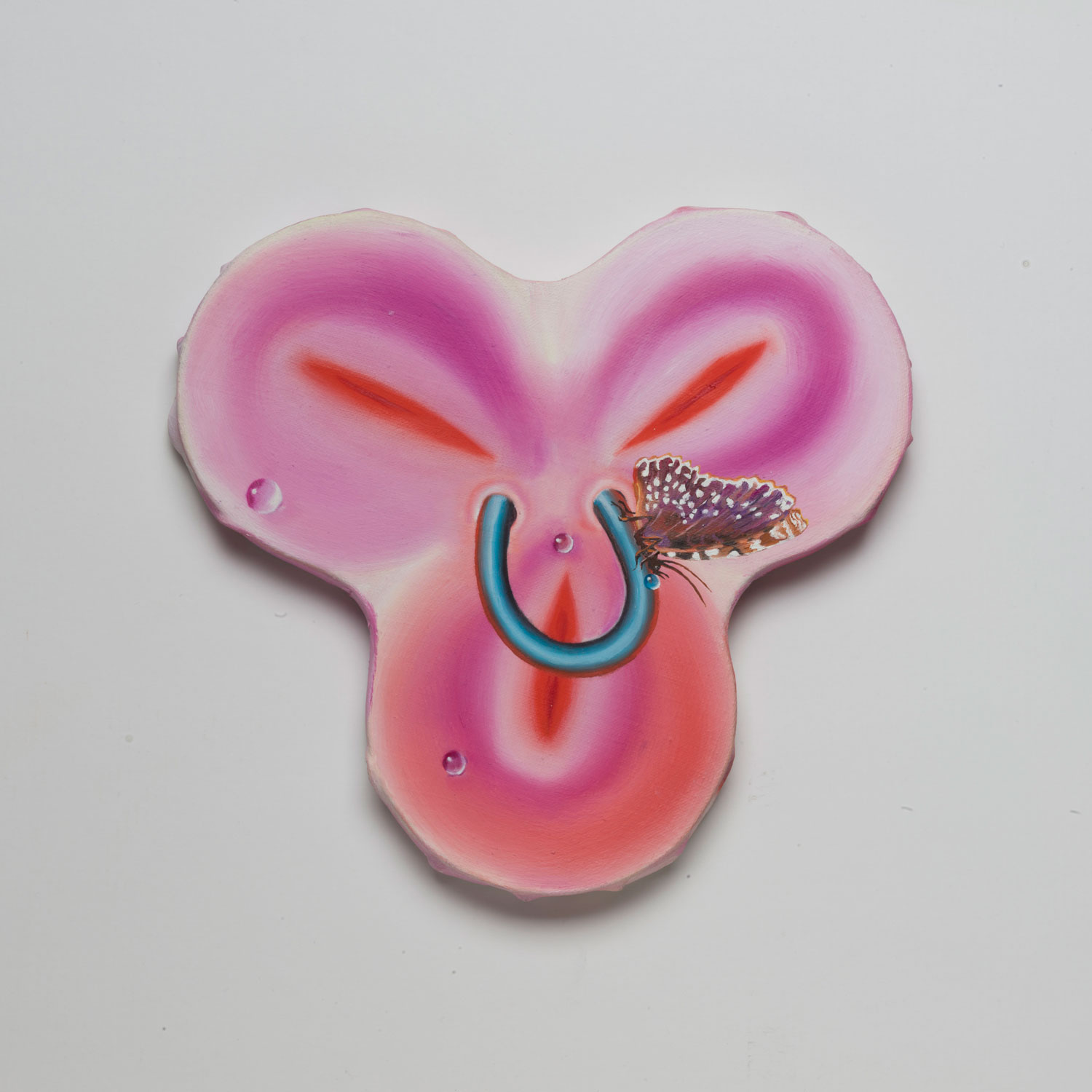
Bertil Almlöf
Born 1930
“Bright Plain”, 2013
Bertil Almlöf’s large oil painting is bathed in light. At first glance, it looks abstract, but the title suggests that it could be a landscape, if you want. Yellow is the dominating colour, but it is not a monochrome. Orange skies are there, and below we see areas of green. Plains are open, flat and treeless terrain that is typically grassy, airy and bright. They are sometimes called savannah or prairie, depending on where you are in the world. Almlöf is a painter and printmaker who studied at the Valand Academy in the 1950s. His artistic practice is characterised by landscapes in strong colours balancing between abstraction and figuration.
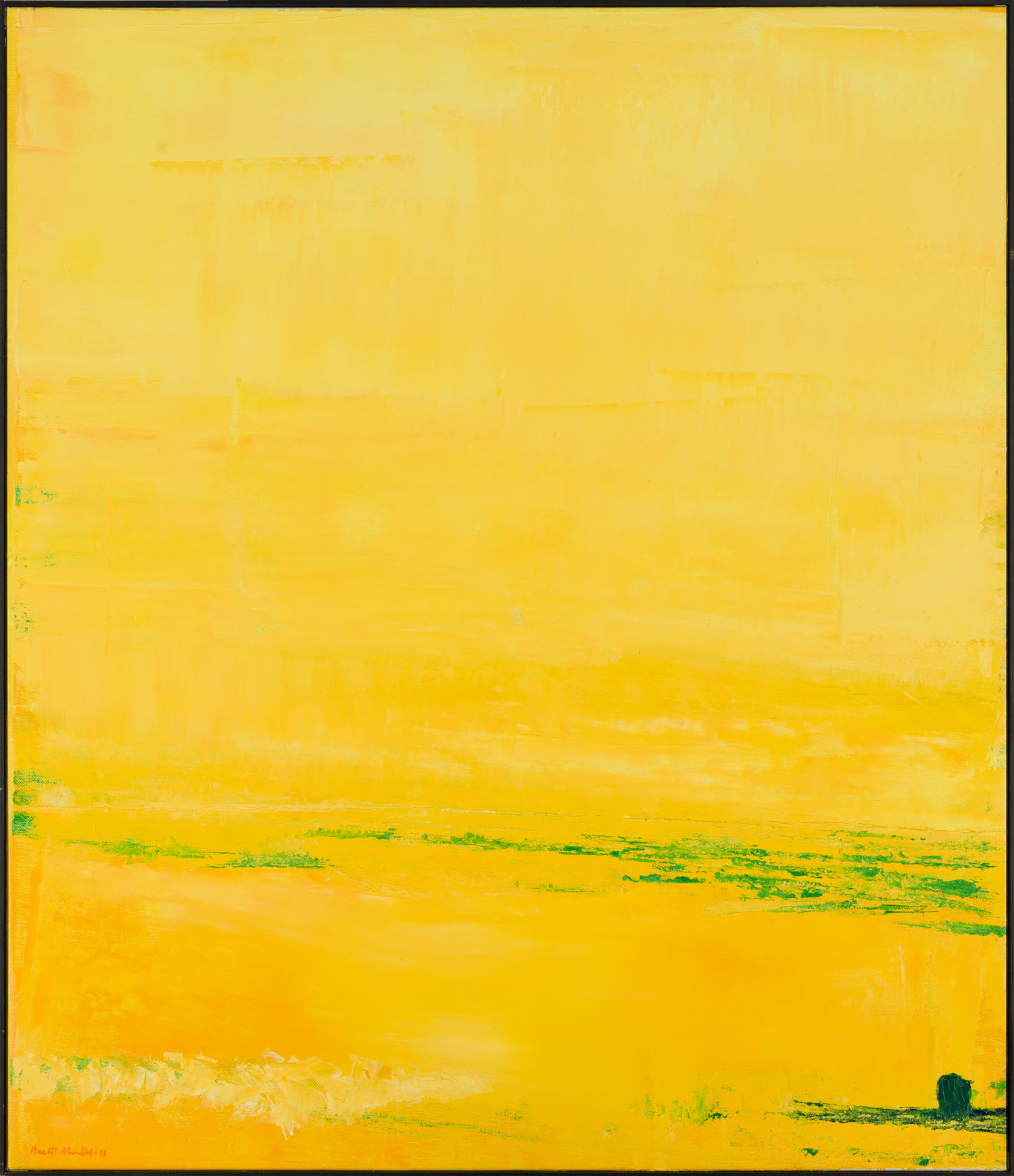
Catti Brandelius
Born 1971
“Public Service”, “Miss Universe Shows Art”; “Streets of Bredäng”; “Art – That’s the Answer”; “On the Underground”
Wearing a tiara as the self-appointed Miss Universe, Catti Brandelius has turned a number of concepts and preconceived notions on their head. In “Public Service”, she appeared as a super-subjective guide at Moderna Museet, showing a selection of works to visitors. In the video “Streets of Bredäng”, she dances with her huge pregnant belly against the backdrop of a 1960s housing development. In connection with Stockholm Art Fair 2001, Brandelius let her camera pan a cross-section of the Stockholm art scene in “Art – That’s the Answer”, where music, as usual, is an essential part of the work. “On the Underground” is a song about prejudices against people from different social classes and backgrounds. “Miss Universe” does not try to please the world; she changes the world so it pleases her. And she is just one of Catti Brandelius’s many alter egos.
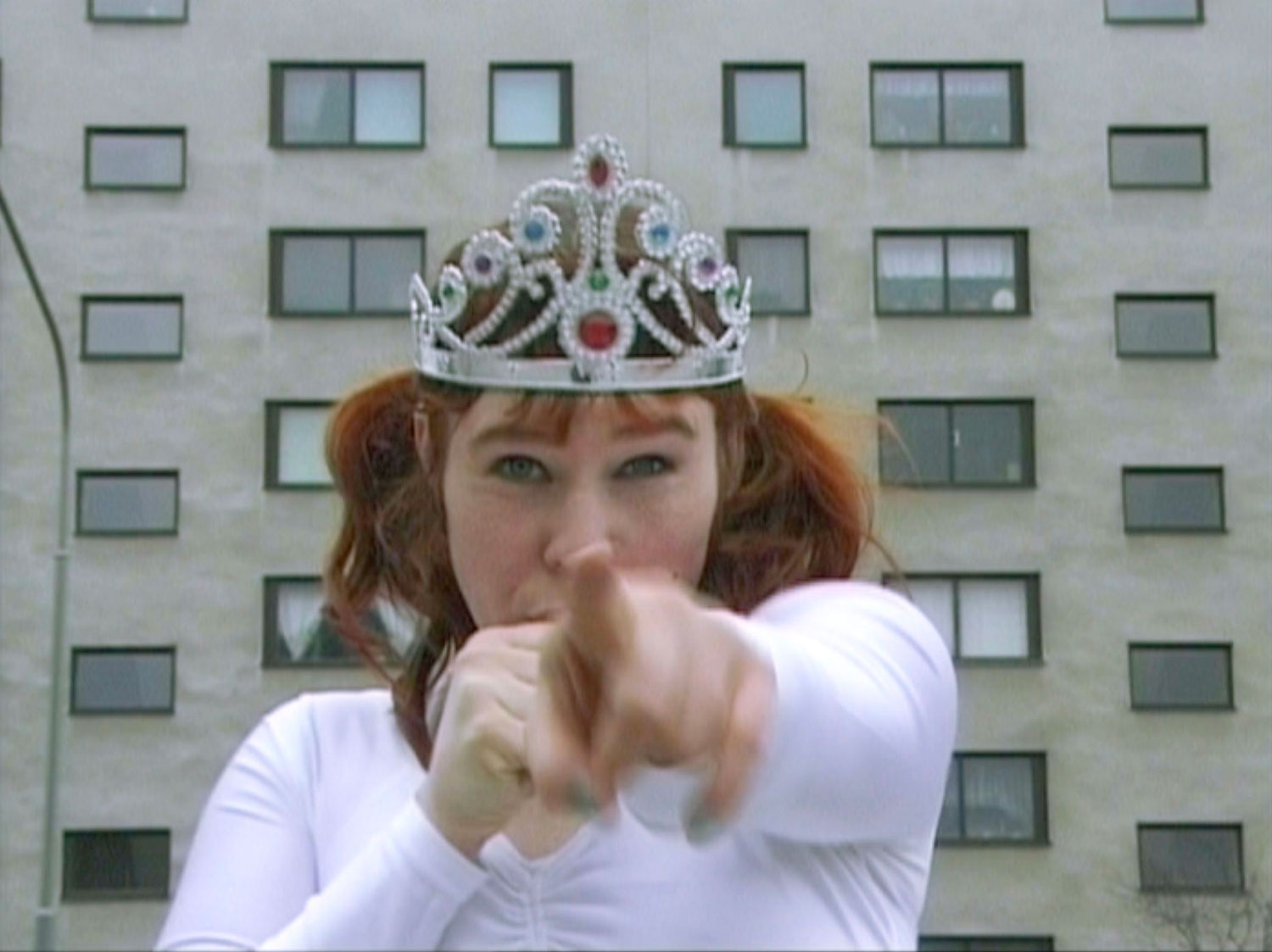
Conny Karlsson Lundgren
Born 1974
“Our Trip to France (Mont des Tantes)”, 2021
At last they will get to meet more people like themselves, gays who share their values. Four young members of the socialist group Röda Bögar [Red Gays] are on their way from the Gothenburg region to an international liberation camp in southern France. The year is 1977, and the fight for gay rights is sweeping across Europe. In the video work, young activists today read the travelogue written by the earlier generation. The travellers’ longings and desires are accompanied by hesitation before the encounter with more experienced men down on the Continent. The Swedish country lads are forced to relate to new ideas on femininity as a weapon in the struggle. The film grows into a touching document about belonging and learning to accept oneself by accepting others.
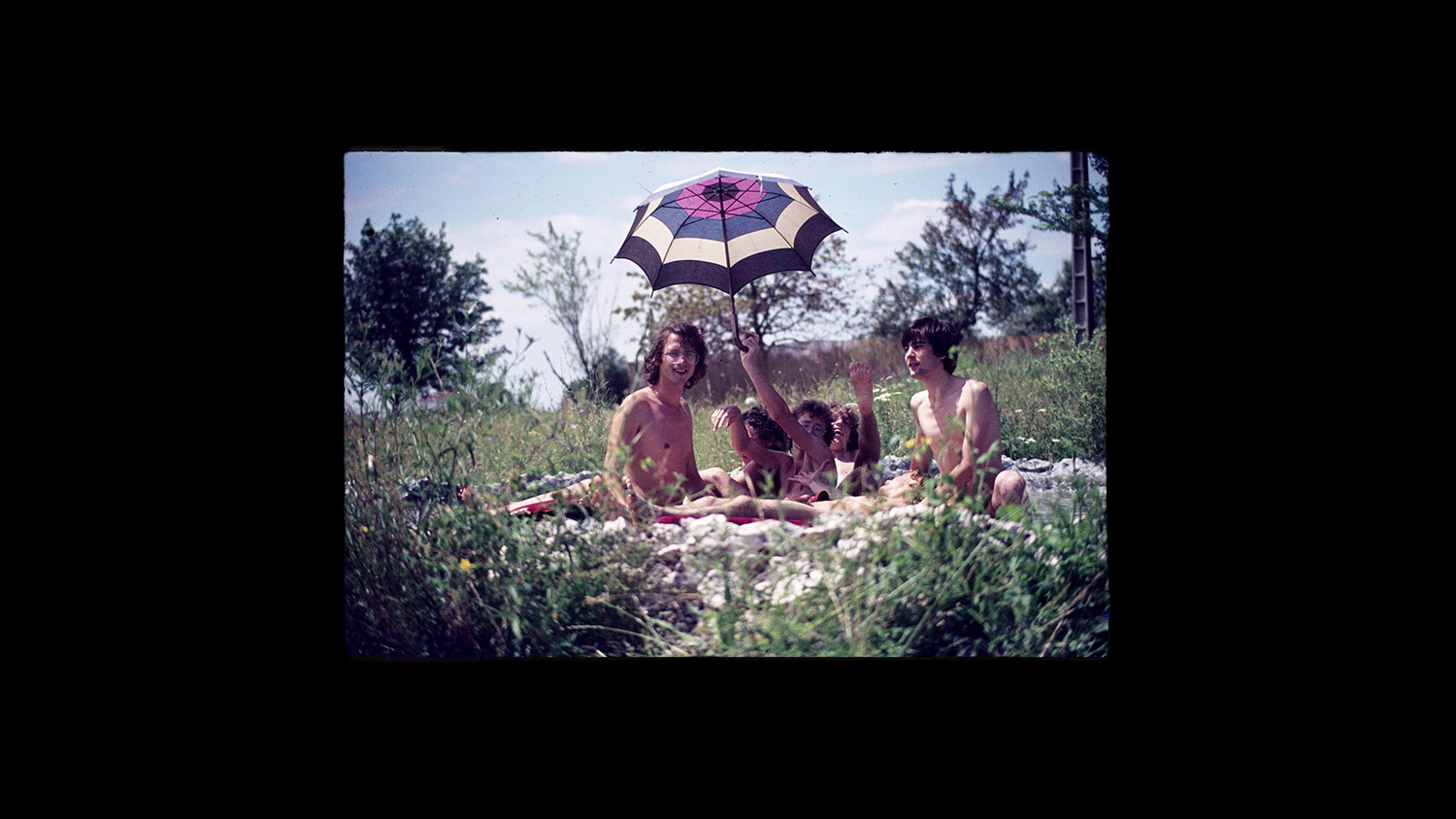
Edith Hammar
Born 1990
“Matches”, 2021
Edith Hammar deftly draws dreamscapes where desire and longing for tenderness and belonging imbue the images with life and sensualism. Sharp contrasts and outlines without shadow are characteristic of their style, and we are invited into the most intimate spaces and situations: couples embracing in a tiled bathroom, sweating in a workshop or languidly playing with fire. Erotic and innocent at one and the same time. The gender nonconforming figures, tight belts, boots, leather trousers and jeans in line with queer aesthetics appear often in Hammar’s singular imagery, giving glimpses from invisible subcultures. Despite the seemingly brutal attributes, the images reveal a warm and considerate affection that radiates love.
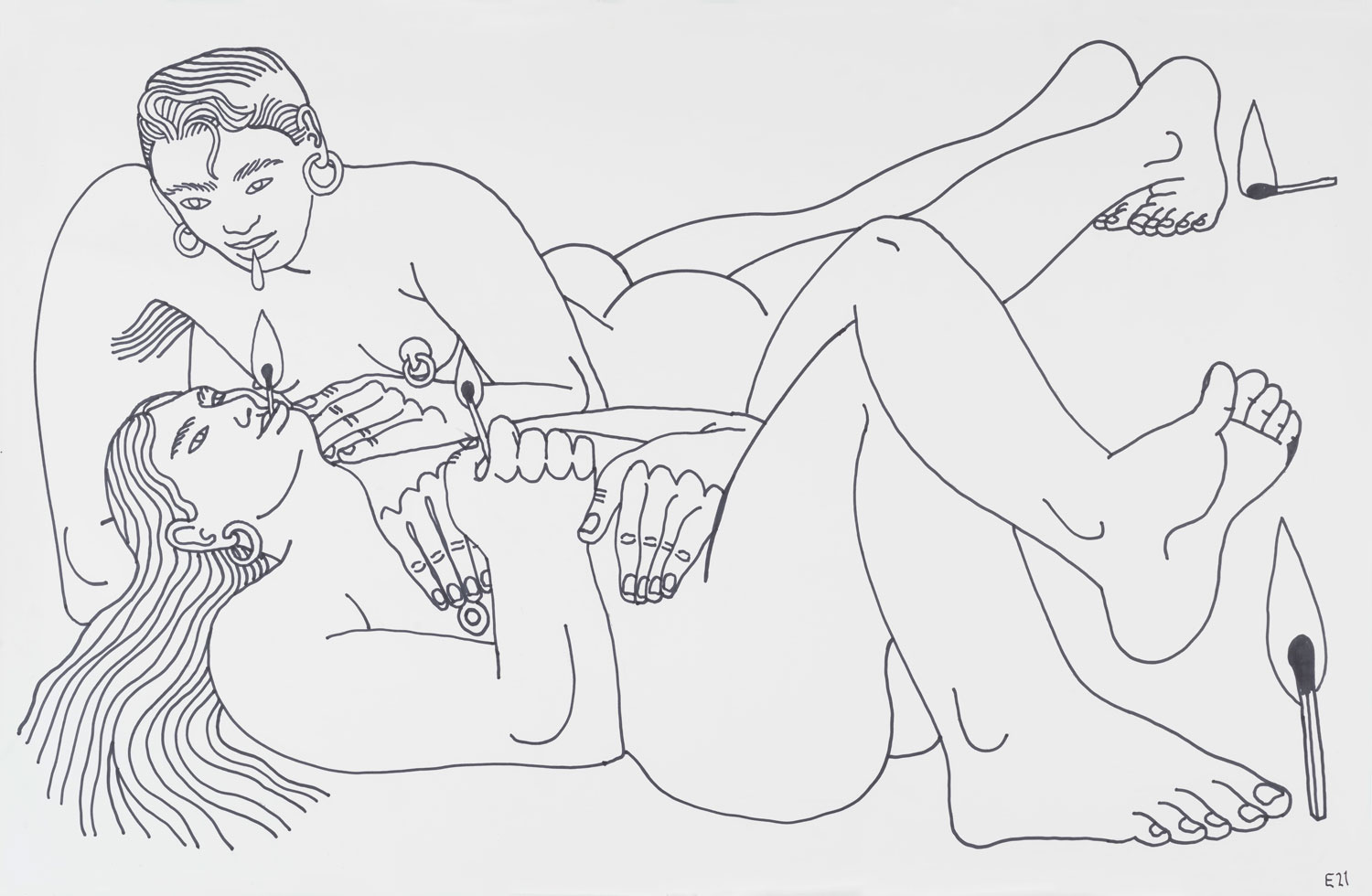
Gerd Aurell
Born 1965
“Swedish Plants”, 1995/2020
Gerd Aurell depicts the plants in Björn Ursing’s handbook “Svenska Växter” (1950), in layer upon layer in a six-day performance work named after the book. Initially, the plants are identifiable, but the image soon turns into something else. At a distance, it is an impelling black hole. If you look closely, you can still make out delicate leaves and stems. Aurell is fascinated by flora and wildlife, and how science has shaped our relationship to them. Her work shows how the Swedish scientist Carl Linnaeus’s linear categorisation of flora and fauna in the 18th century continues to influence our attitudes to nature and the dichotomy of order and chaos.
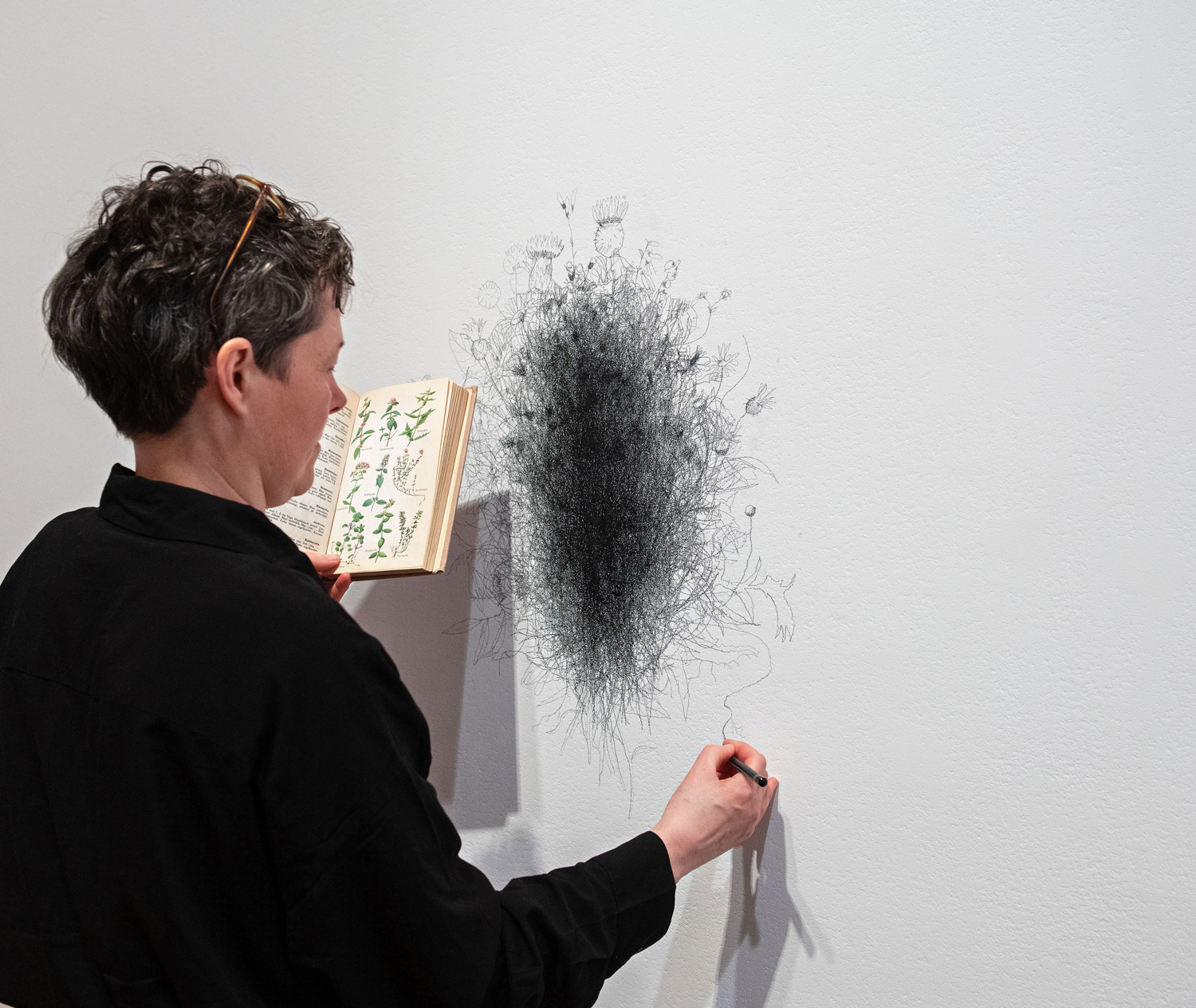
Gittan Jönsson
Born 1948
“Drontheimer strasse 36a!”, 2018
“Drontheimer strasse 36a!” is a painting of Gittan Jönsson in her studio in Berlin, the city she moved to in 2010 to live and work. The artist sits looking at paintings at different stages, including Drontheimer strasse 36a!, in a kind of meta-gesture. Outside the window, another layer of reality, a tiny speck, an airplane about to land on the now-defunct Tegel airport. The political tendencies around 1968 informed Gittan Jönsson’s practice, which has been seminal to feminist art in Sweden. Her imagery combines socially-committed and poetic renderings of life.
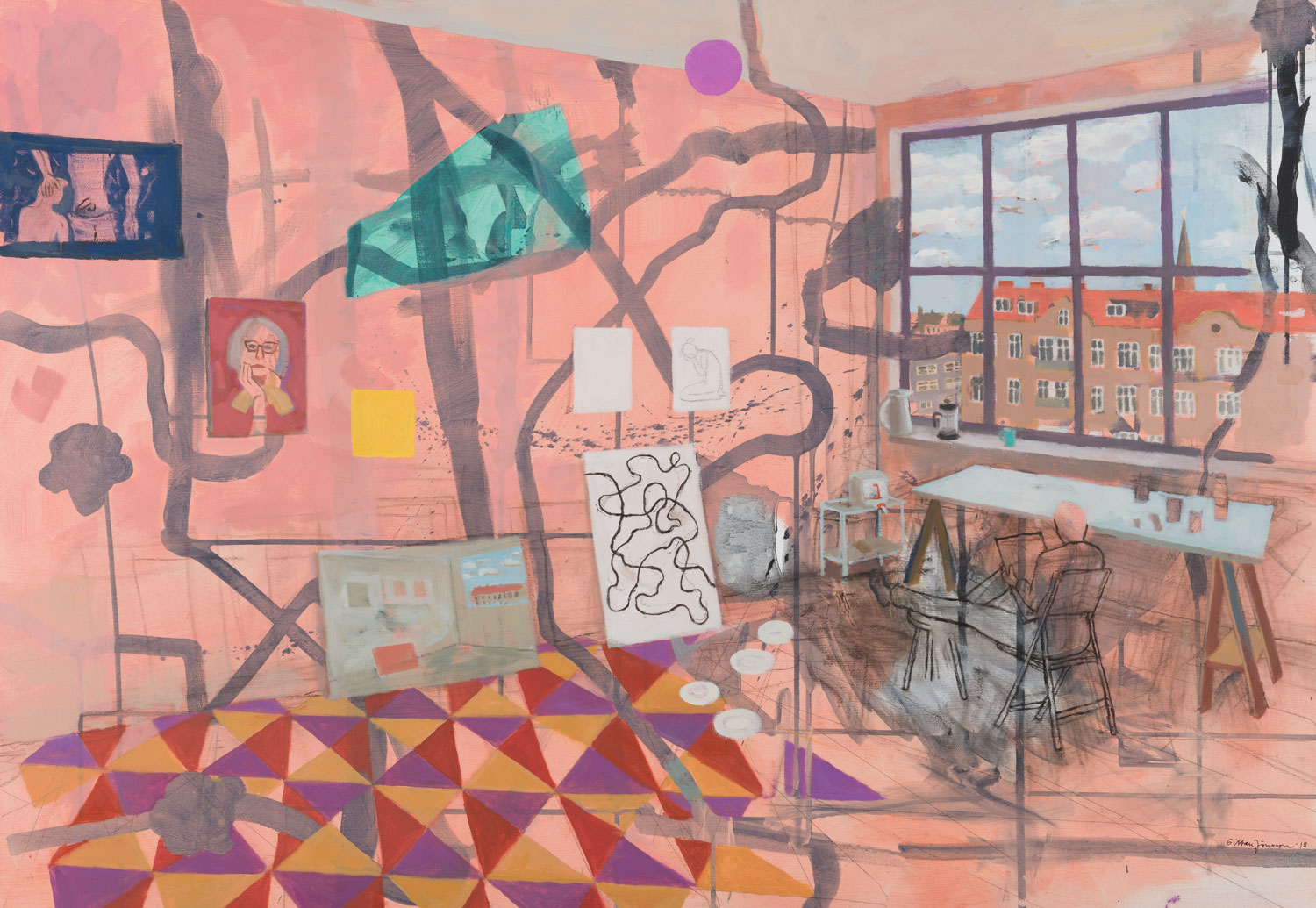
Goldin+Senneby
Formed in 2004
“Insurgency of Life (Lego Pedometer Cheating Machines)”, 2019
With “Insurgency of Life” Goldin+Senneby look back at fifteen years of working together, and the way an autoimmune condition has played a role in forming their practice. This is one third of the work, which revolves around the vulnerable body’s interplay with the inner logic of capitalism. In performative interventions inspired by the financial world’s strategies of evasion and the sleight of hand of magic, Goldin+Senneby have, through the years, worked in the virtual sphere. Here it is instead the body that is revealed as the limit of possibility. Each Lego robot, constructed according to YouTube tutorials, is designed to shake a smartphone in order to trick its step counter and, by extension, insurance companies and other agents that harvest patient data. Against a backdrop where the individual body’s needs are not what is counted, the work interrogate ideas such as dependency, care, and the ingenious power of humans.
The artwork is not on display due to technical reasons.
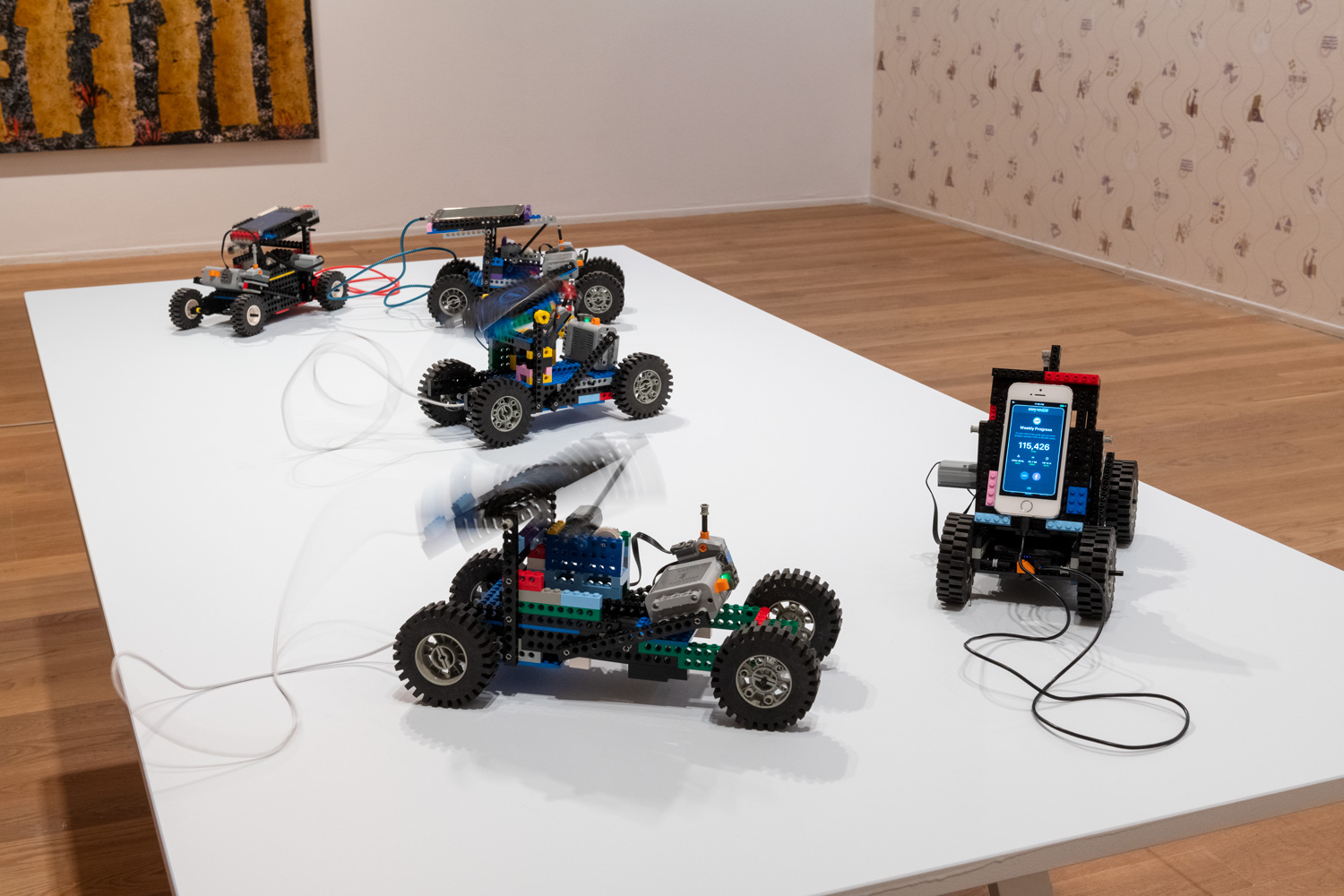
Ingrid Furre
Born 1983
“The blue sphere”, 2018
Ingrid Furre is as captivated by materials and sculpture as she is by text and the human body. Her own materials range from the fragile, such as wax, fabric and soap, to the more permanent, like concrete, bronze and aluminium. Her work “The blue sphere” consists of fifteen individual objects cast in wax. Together they form a single sculpture which, through its individual parts, tests the somewhat blurred borders of sculpture as a medium. Wax is solid at room temperature but turns liquid when warmer. The shapes resemble plinths or seats abandoned after some kind of social gathering, or perhaps a multiplicity of the letter ‘M’, spelling out a sound of delight or agreement.
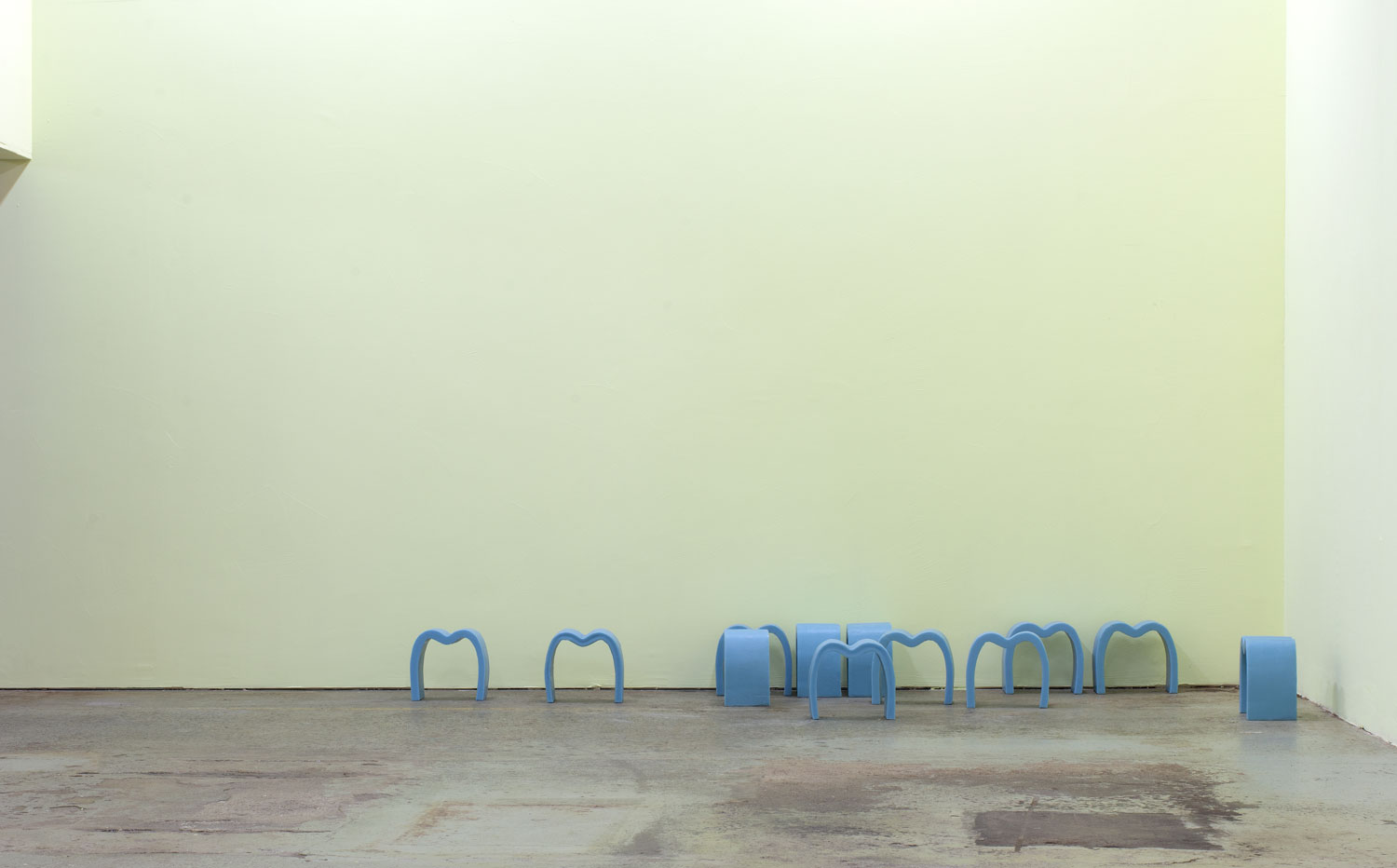
Iris Smeds
Born 1984
“The Average”, 2019, and “0–9 Bye (a bug’s life)”, 2018-2019
The film “The Average” is a comment on the individualism that has emerged alongside the decline of the welfare state. The introductory monologue on time and space, body and normality, is accompanied by the sound of crackling flames. The fire is warming but also destructive. Better to burn up, however, than to slowly fade in a liberal-market society that demands that individuals are forever competitive. “0-9 Bye (a bug’s life)” is a sculpted cloak in pink satin marked with the numbers 0 to 9. It can be read as an allegory of life’s movement towards death, or simply as numerals. The mantle reminds us of the butterfly that has reached life’s climax after the pupa phase. In her practice, Iris Smeds works with performance, film and objects. The value of art and the marketability of identities are recurring subjects, and her works are often blended with absurd humour.
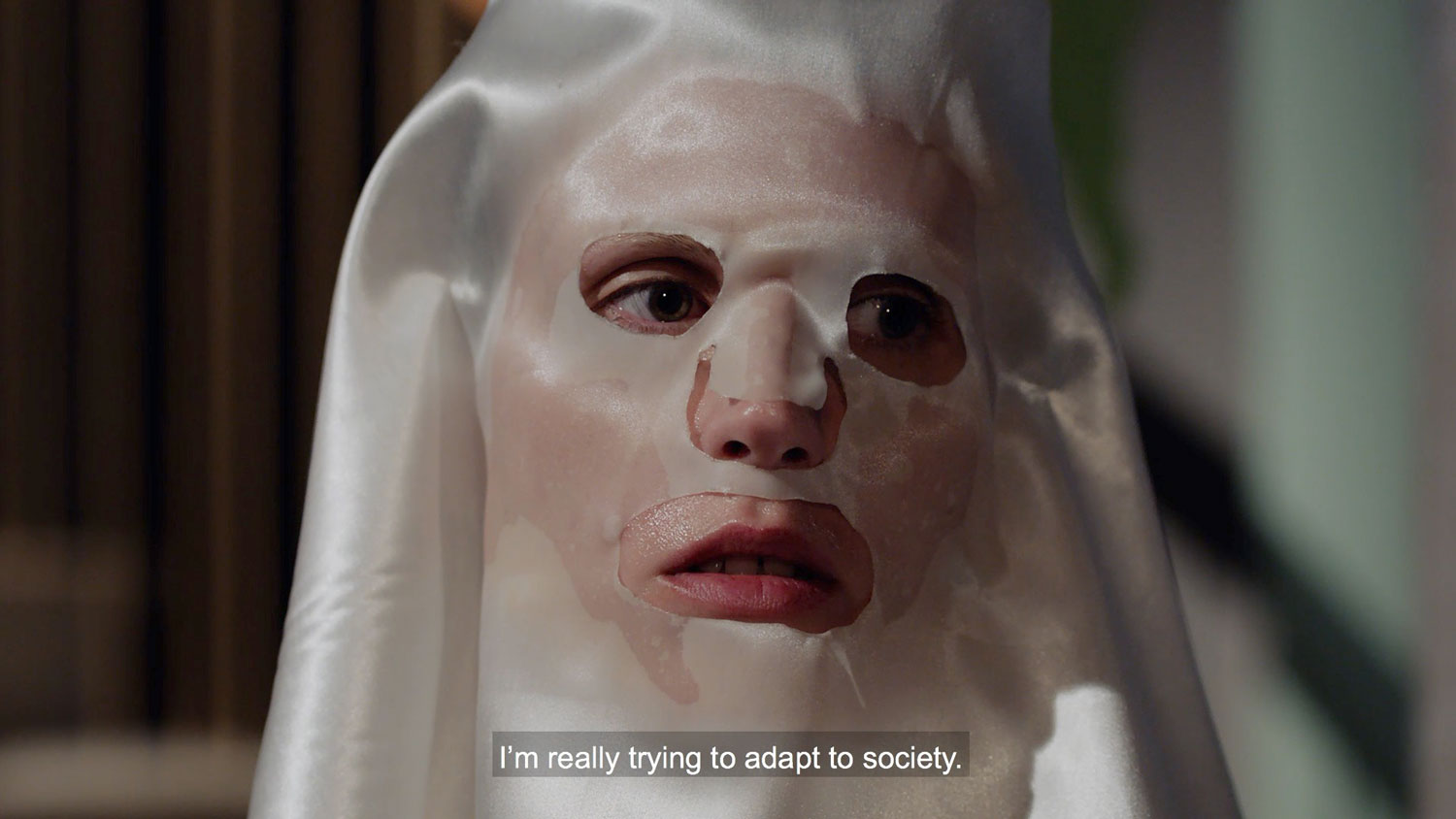
Jan Cardell
Born 1961
“Bug”, 1998
With a body made of papier-mâché and legs of steel, Bug is a sculpture and an instrument that generates sounds with handmade copper spools. The sound resembles how insects communicate with each other, moving so they click, buzz and whirr. Since the 1990s, Jan Cardell has been developing various kinds of objects that combine organic imagery with composed music and more interactive material. This particular work creates acoustics mechanically through analogue technology and digital programming. Bug also combines kinaesthetic expression, movement and rhythm, and relies on our ability to perceive similarities and experience new creations.
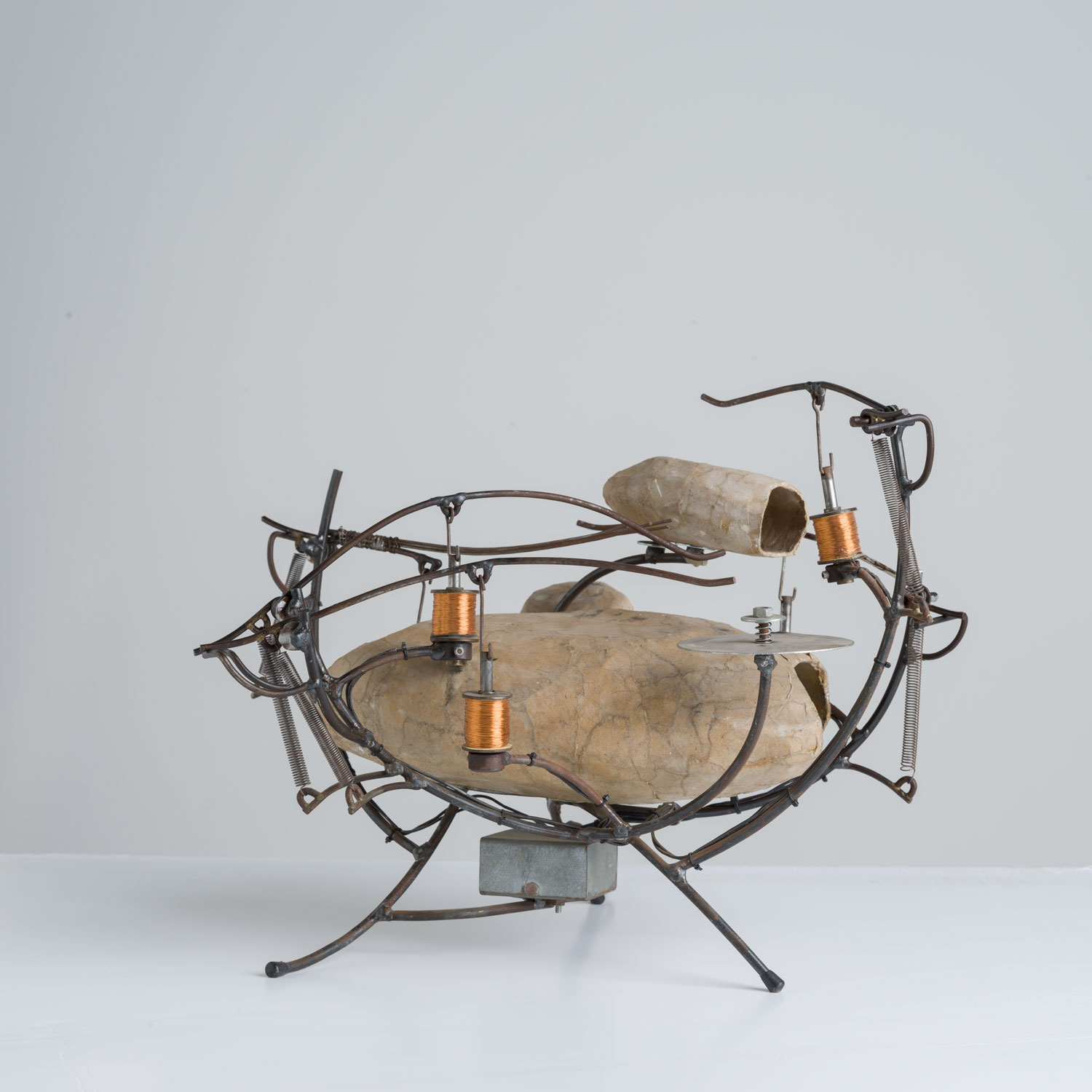
Jenny Olsson
Born 1973
“Luft” och “Eld”, 2020
Copperplate etching is a process of contrasts, of dissolving and combining, of great pressure, chemical processes and stencils. In the pieces “Air” and “Fire” Jenny Olsson has examined a simple shape and the way it can shift in scale from something very small to something enormous. The shapes are reminiscent of cells or the earth. The origins of the particular colours used and their associations, such as transparency and strength, are also significant in the two etchings. Olsson takes inspiration from the French philosopher Gaston Bachelard (1884-1962) and his almost esoteric theories of the four elements, where unexpected connections between nature and human, science and poetry are drawn.
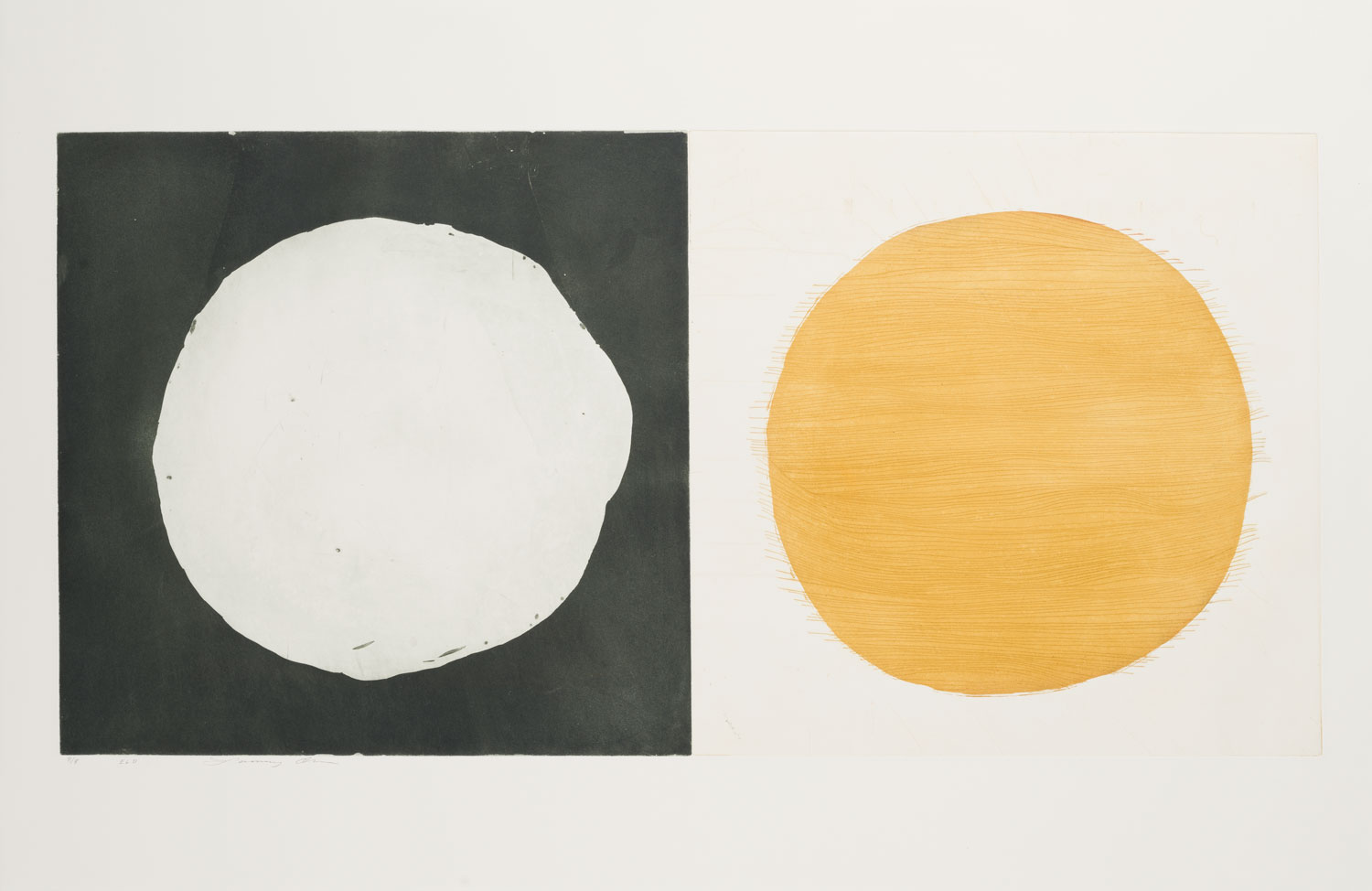
Joakim Kocjancic
Born 1975
“Piazza San Marco, Venice”, From the series “Europea”, 2009/2021
Joakim Kocjancic is rooted in a tradition of documentary photography. The black-and-white images that form the series and photo book “Europea” were shot spontaneously in streets and squares all over Europe. Kocjancic has lived and worked in numerous European cities. With his camera, he reflects himself and others. The images are simmering with life and are nevertheless melancholic. This is a beloved Europe, with a dark history and an uncertain future. In “Piazza San Marco, Venice” the sinking city’s most famous square forms an uncanny backdrop for the remarkable figure hovering skywards.
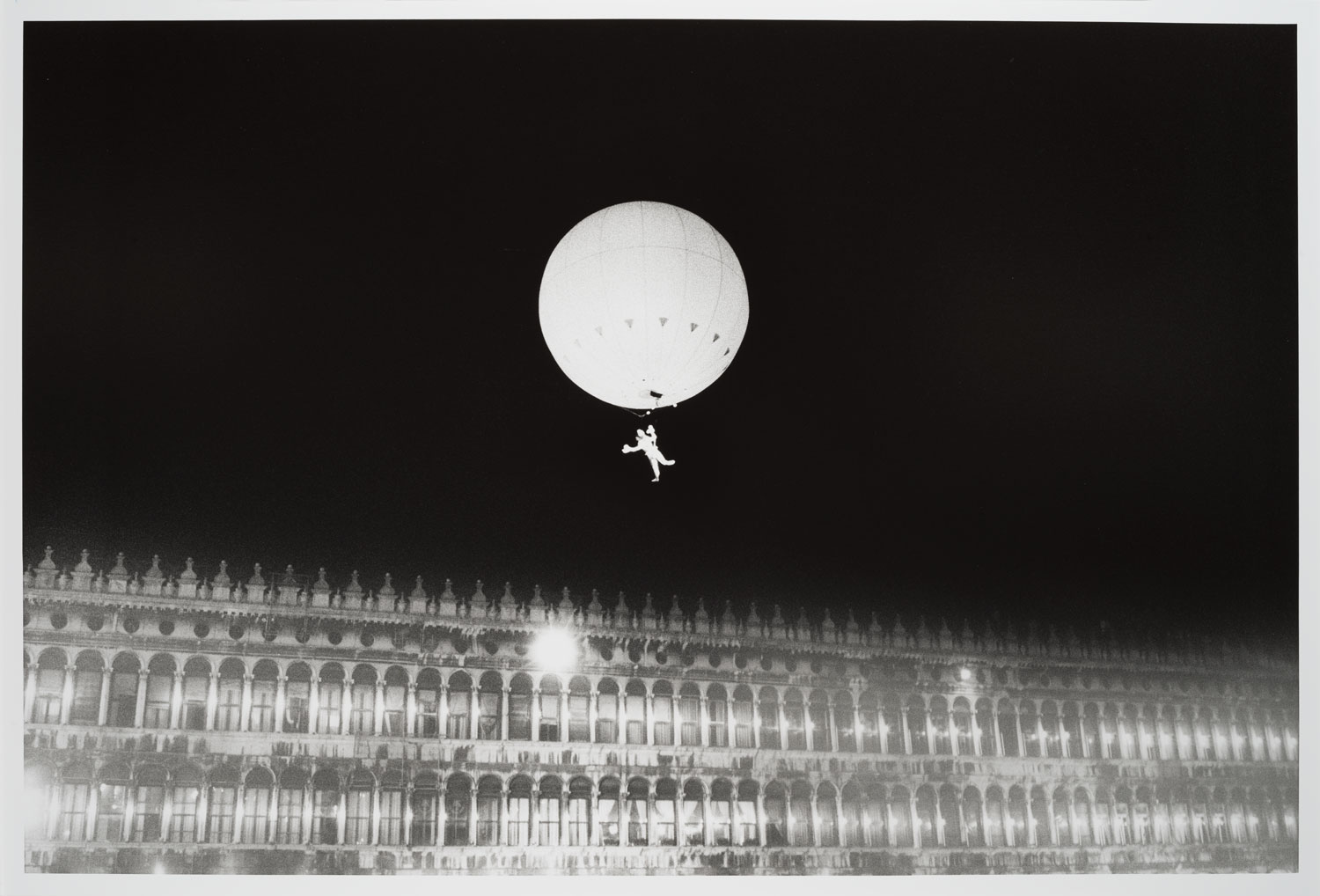
Joar Nango
Born 1979
“The Indigenuity Manifesto”, 2016
Joar Nango’s practise balances on the boundary between architecture, design and visual art. His works are often processual, socially oriented and influenced by Sami philosophy and new technology. In this text-based video manifesto, he focuses on temporary spatial solutions in Sápmi. The term “indigenuity” combines the words “indigenous” and “ingenuity”. As a consequence of centuries of co-existence with an extreme climate, the Sami have adapted to the environment in surprising and creative ways. Their ingenuity generates solutions to facilitate everyday life in nature. All the objects and materials have the potential to be something totally different. This DIY mentality contrasts sharply with the consumerism of commodity society. Frugal use of resources becomes an act of resistance.
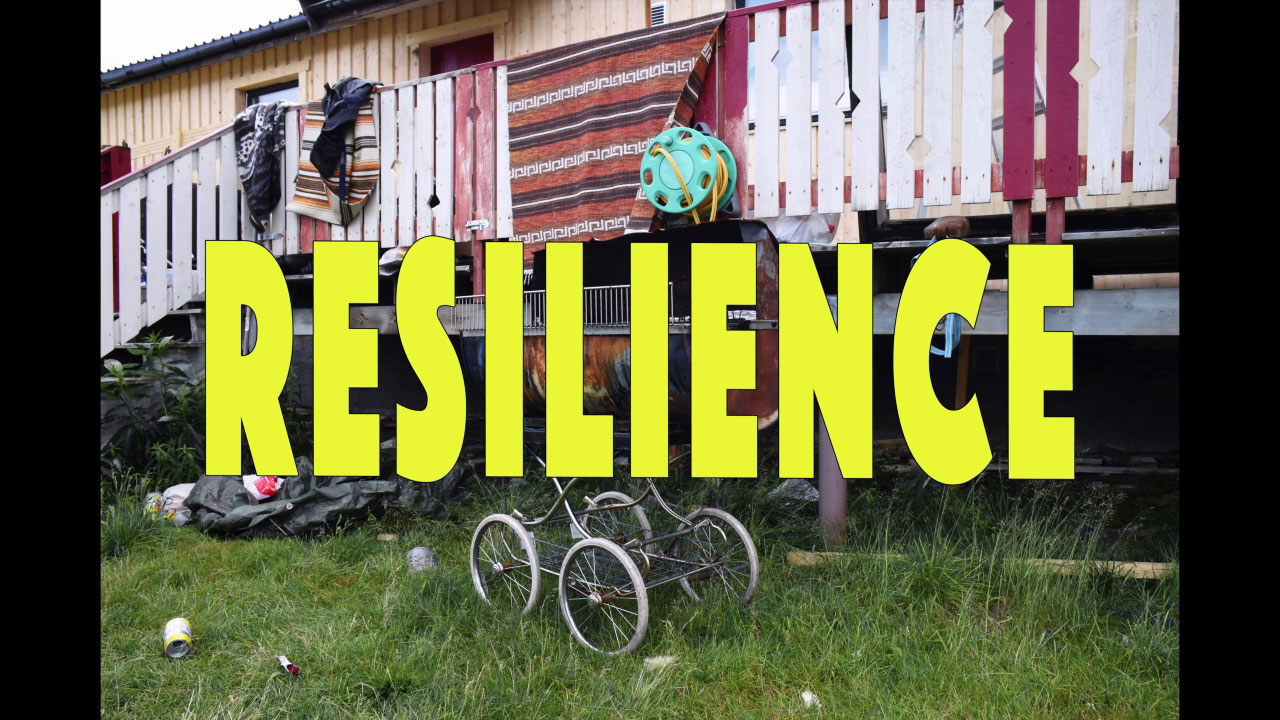
Jörgen Hammarberg
Born 1941
“SMOKES”, 1966
“SMOKES” is part of a series of paintings from the 1960s, created in a choreography with a dancing flame that sweeps across the canvas. Close, but not too close, since the object never was to perforate the fabric or create charred holes. Instead, the flame has tenderly caressed the air and touched the surface, leaving traces from the heat. A meditative concentration exercise, something every painter does now and then, but usually with a paint brush. A slightly distracted movement, and suddenly it’s too late. Like life itself: One mistake can change everything.
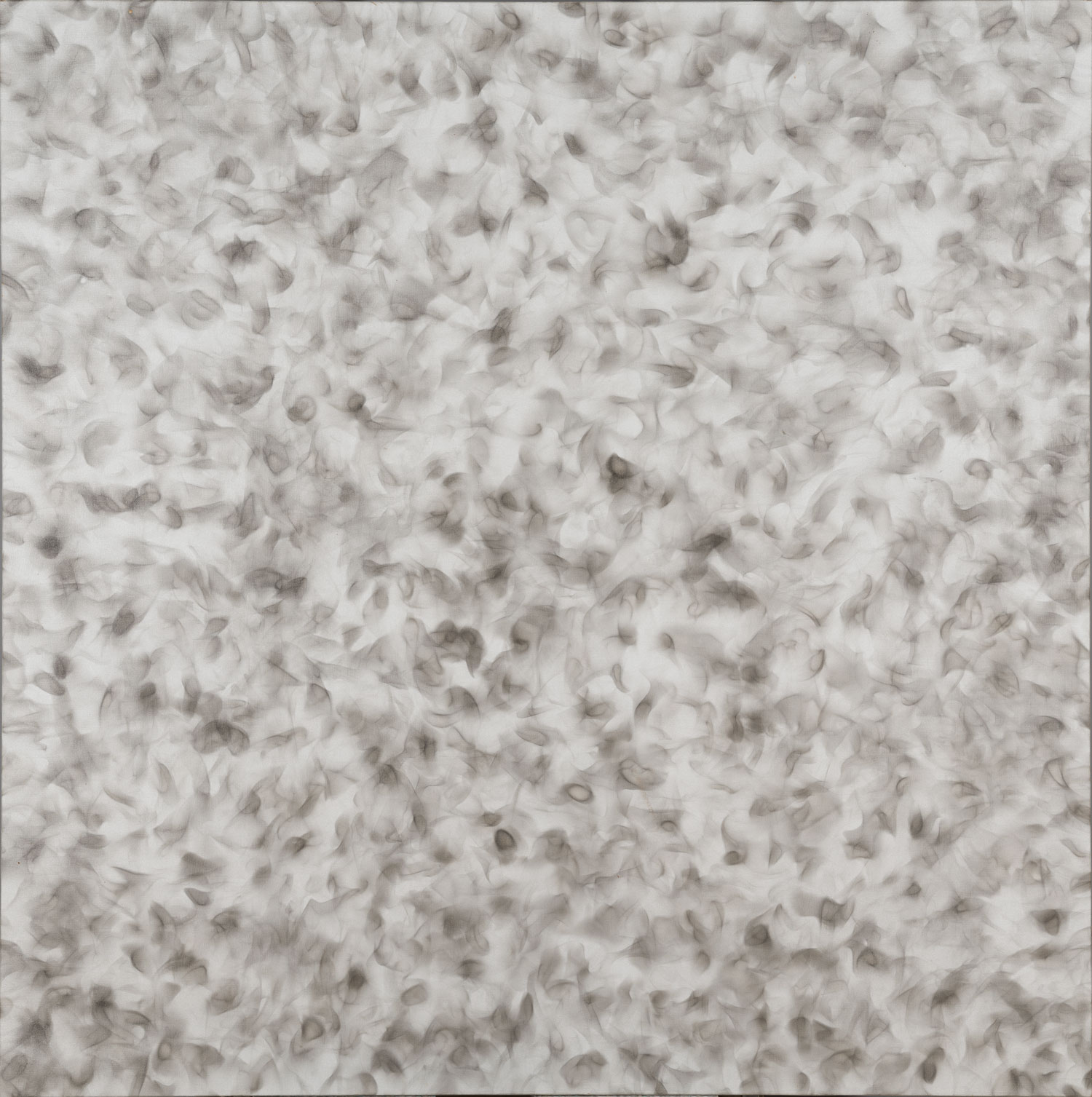
Jörgen Svensson
Born 1941
“Insert”, 2017
A graduate from the Valand Academy, Jörgen Svensson also has a BA in sociology. His interest in behavioural science is obvious in the extensive projects he pursued over many years, which penetrated the social fabric. The social element was something Svensson brought with him in 2008 when he began increasingly to work on images, alone in his studio. His paintings are strongly impacted by Svensson’s background in an industrial town in Värmland, where textiles and crafts were important means of expression. In this picture, we see the pillars of society, representations of municipality, region, church and state. Svensson has laboriously applied paint to cotton fabric with an injection needle. The procedure alludes to memories of some of his childhood friends in the community where he grew up, who were let down by society’s institution and died from substance abuse.
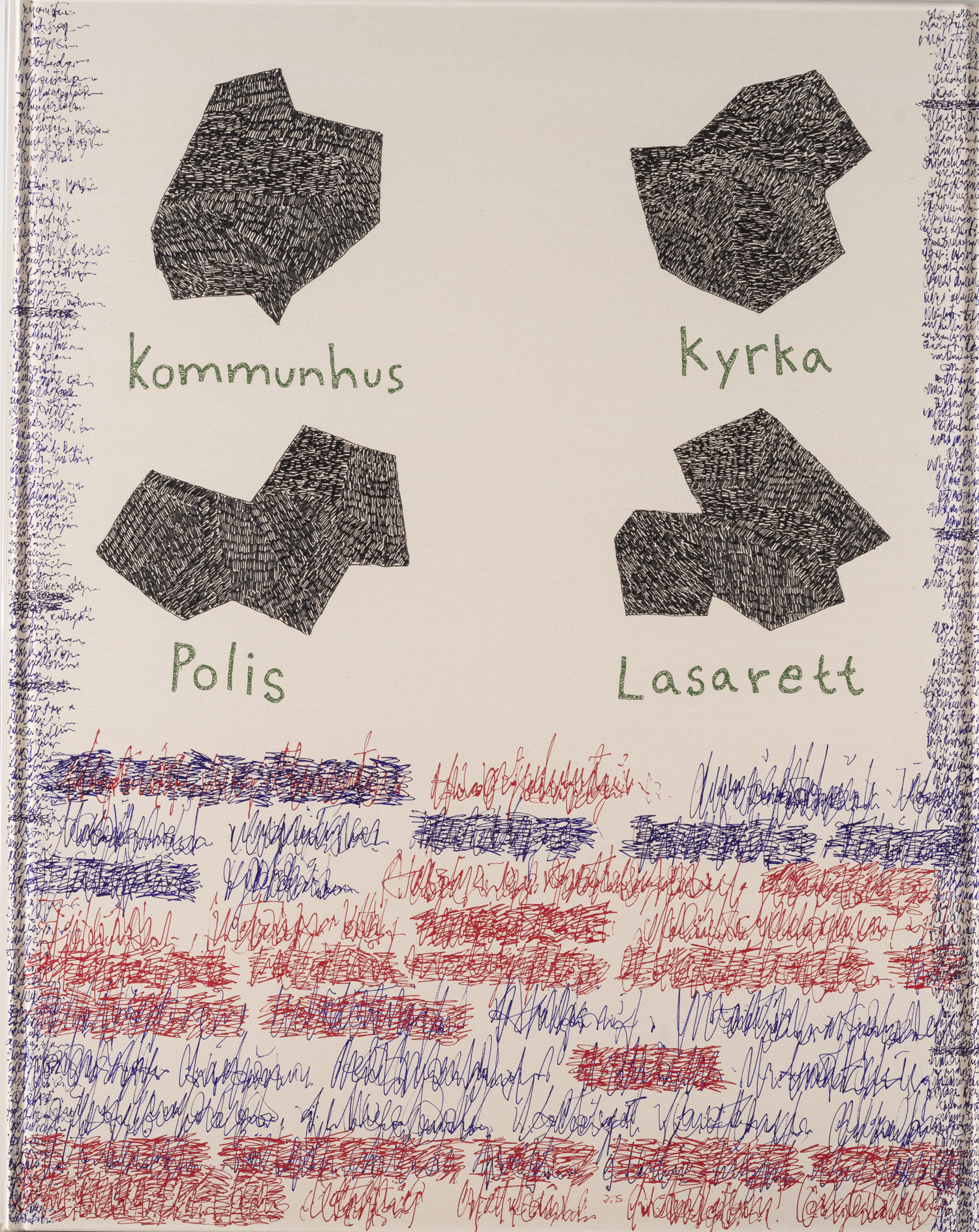
Kultivator
“The Landscape”, 2021-
“The Landscape” is a link between Moderna Museet and Kultivator, where the latter undertakes to increase biodiversity on a piece of leased land on Öland. There are two copies of the contract. One copy, “attested” by a piece of soil from the leased land, is shown in a glass display in the Museum. The other copy is stored in an identical display at the Kultivator farm, where it is regularly filled with traces or objects from the ongoing activities in the landscape. This display unit will be donated to Moderna Museet after five years. The work, Landscape, can be seen as a performance where the artists’ actions in harmony with the various ecosystems represent the landscape on Öland. Kultivator is an experimental organic farming and art cooperative located in Dyestad on Öland.
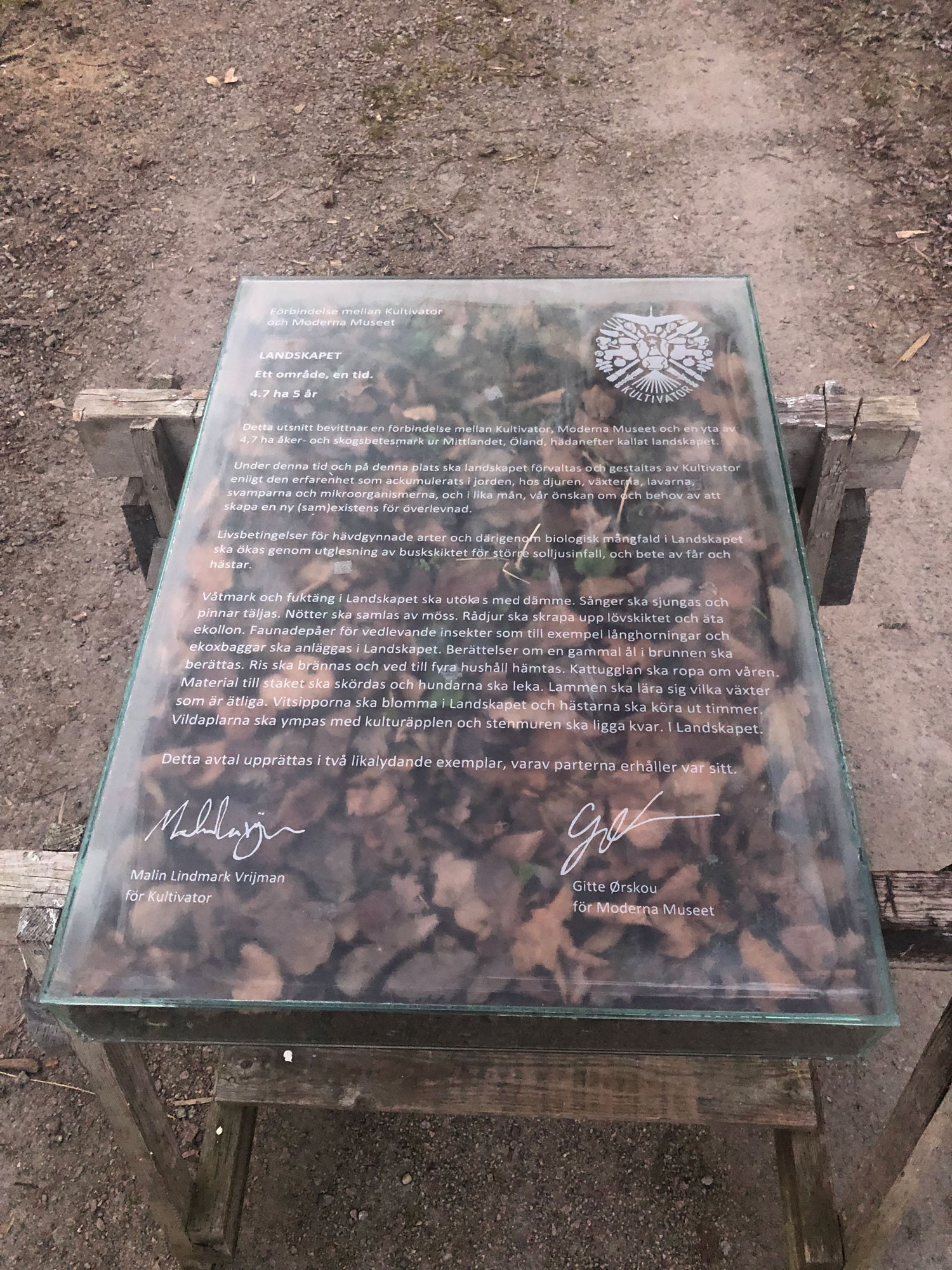
Leif Holmstrand
Born 1972
“Anadyomene”, 1999–2007 and “Berlin Magic Model Project / Prostitution and Other Activities”, 1999
Leif Holmstrand’s physical works are often drawn from his performative practice. The sculpture “Anadyomene” is, for example, based on the performance “Berlin Magic Model Project / Prostitution and Other Activities”. Anadyomene, from the Greek “Venus Rising From the Sea”, was a common motif in the art of antiquity and during the Renaissance. Here we encounter the goddess of love in a different guise, bound together with violence and darkness. She rises from the depths ensnared by a squid-like net, carefully woven with rubbish from the streets of Berlin. Her birth is brutal: according to legend she was born from the sea foam produced by her father Uranos’ severed genitals being thrown into the ocean. Emerging from Leif Holmstrand’s rich artistic and literary practice is a diverse world. One peopled by figures of transgressive gender identities who, with all their senses vibrating, are exploring the human condition and the subversive power of culture.
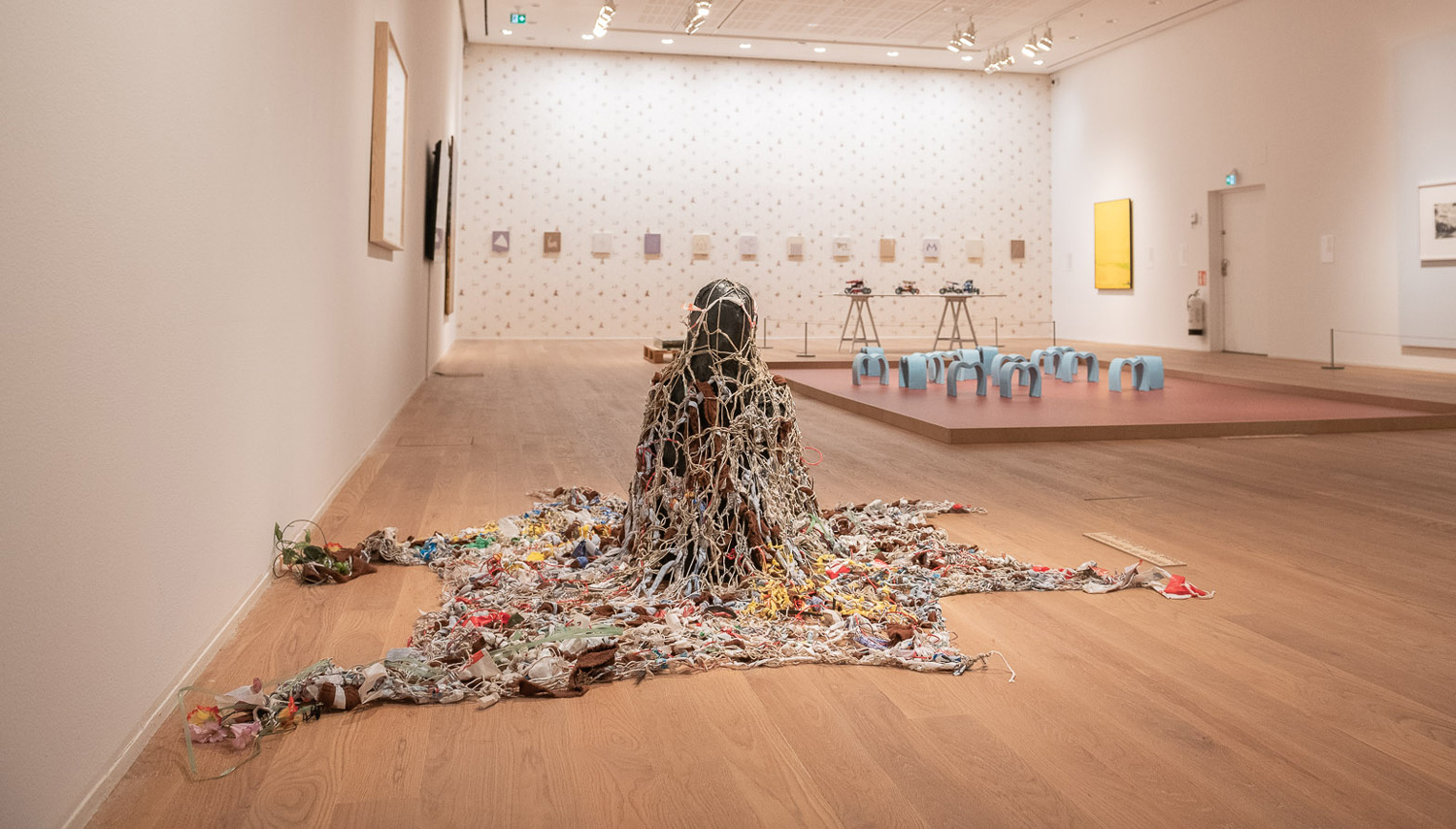
Lotta Antonsson
Born 1963
“SEA”, 2019 and “Coral Arm (From the series Body of Geology)”, 2016
Putting oneself in front of the camera and using one’s own body to portray not a specific woman but a cliché, woman as the dream vision of a male, controlling gaze, was a strategy used by a number of seminal Swedish women artists as a way of focusing on whose gaze is reproduced by the camera lens. They were influenced by American postmodern feminist theory and had a major breakthrough in Sweden in the early 1990s. Lotta Antonsson was one of them. For three decades, she has continued to deliver urgent works that expand our notions of photography and its potential. In recent works, Antonsson has employed collage techniques, often introducing pictures from 1960s and 1970s magazines and adding objects such as seashells to their surface, or photographing the collage and giving rise to a totally new two-dimensional image.
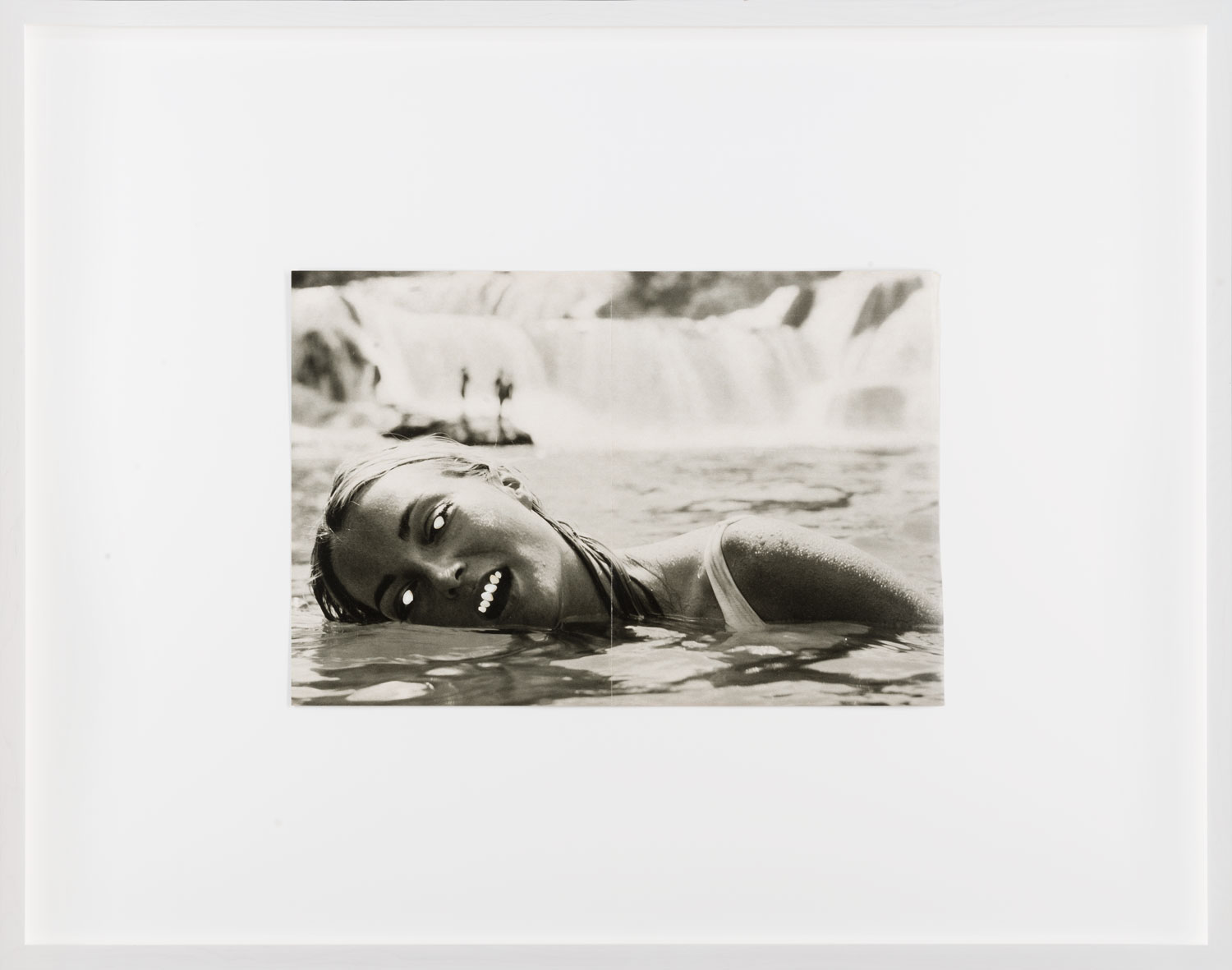
Margareta Hallek
Born 1932
“Dotted Variable”, 1964
Margareta Hallek is a prominent figure within Swedish experimental art, celebrated for her postmodern and playful approach to material. Hallek belonged to a generation of young textiles students at Konstfack – the University of Arts, Crafts and Design, who at the beginning of the 1960s wanted to stretch the limits of arts and crafts by working freely with fabric as an art form. Shaping textiles with needle and thread was to her as natural and urgent as using paints and brushes. In her ‘textile paintings’ she began experimenting with having the public take part in their artistic creation. When “Dotted Variable” was first shown the viewers could move its “ties” themselves, altering the composition of the piece.
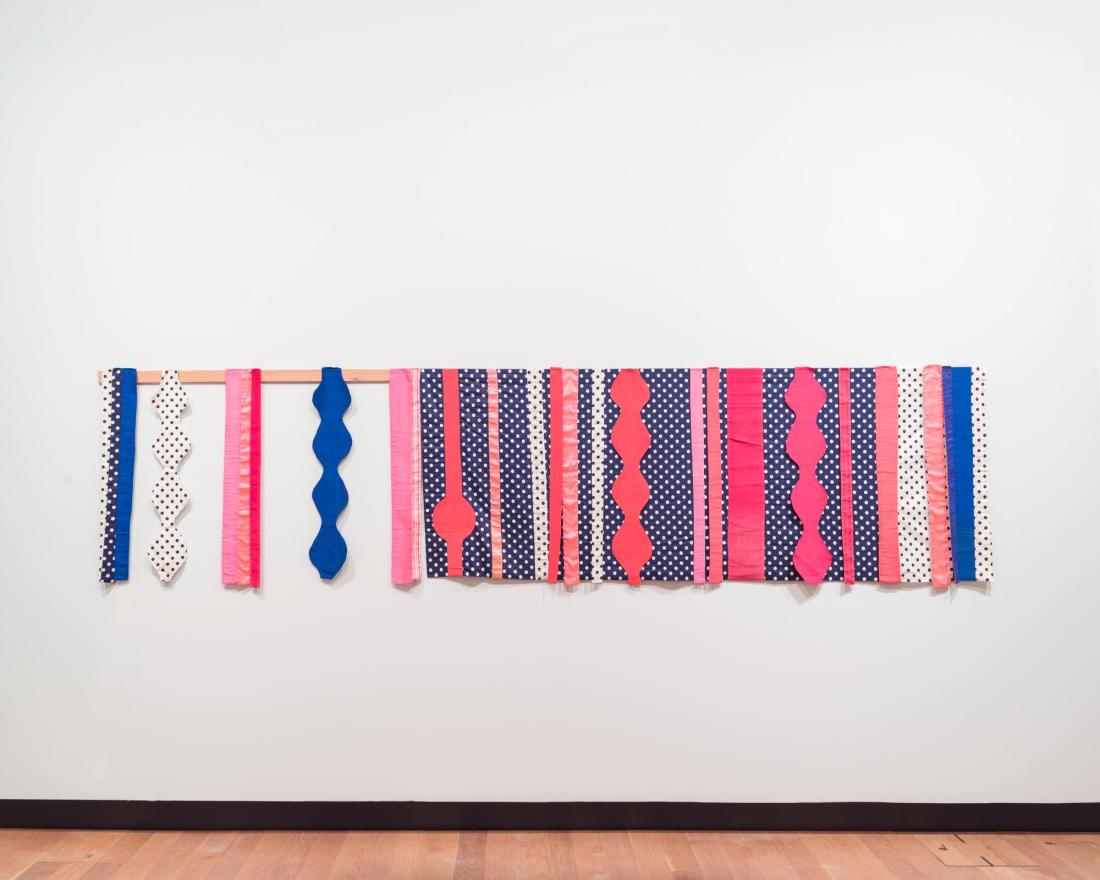
Matti Sumari
Born 1987
“sad slag platters”, 2021
Matti Sumari processes found materials dumped in his surroundings, often in and around the Alta studio building on Celsiusgatan in Malmö. Plastic crates for fruit from all over the world, bike stands, punnets and pickled vegetables. Sumari’s practice combines his interest in the circulation of commodities, economic systems and microorganisms. The social sculpture project sad slag platters transforms waste from art previews, non-refundable beer cans, into a memorial. Visitors contribute their empty cans, and the aluminium is melted in a furnace made out of a metal barrel for “Consumer’s Pride”, genetically modified soya bean oil from India. Casts of pickled cucumbers and fragments of plastic crates become sculptural collages, as polished and shiny as jewellery. Like distilled images of the collective pleasure of an evening in the company of art.
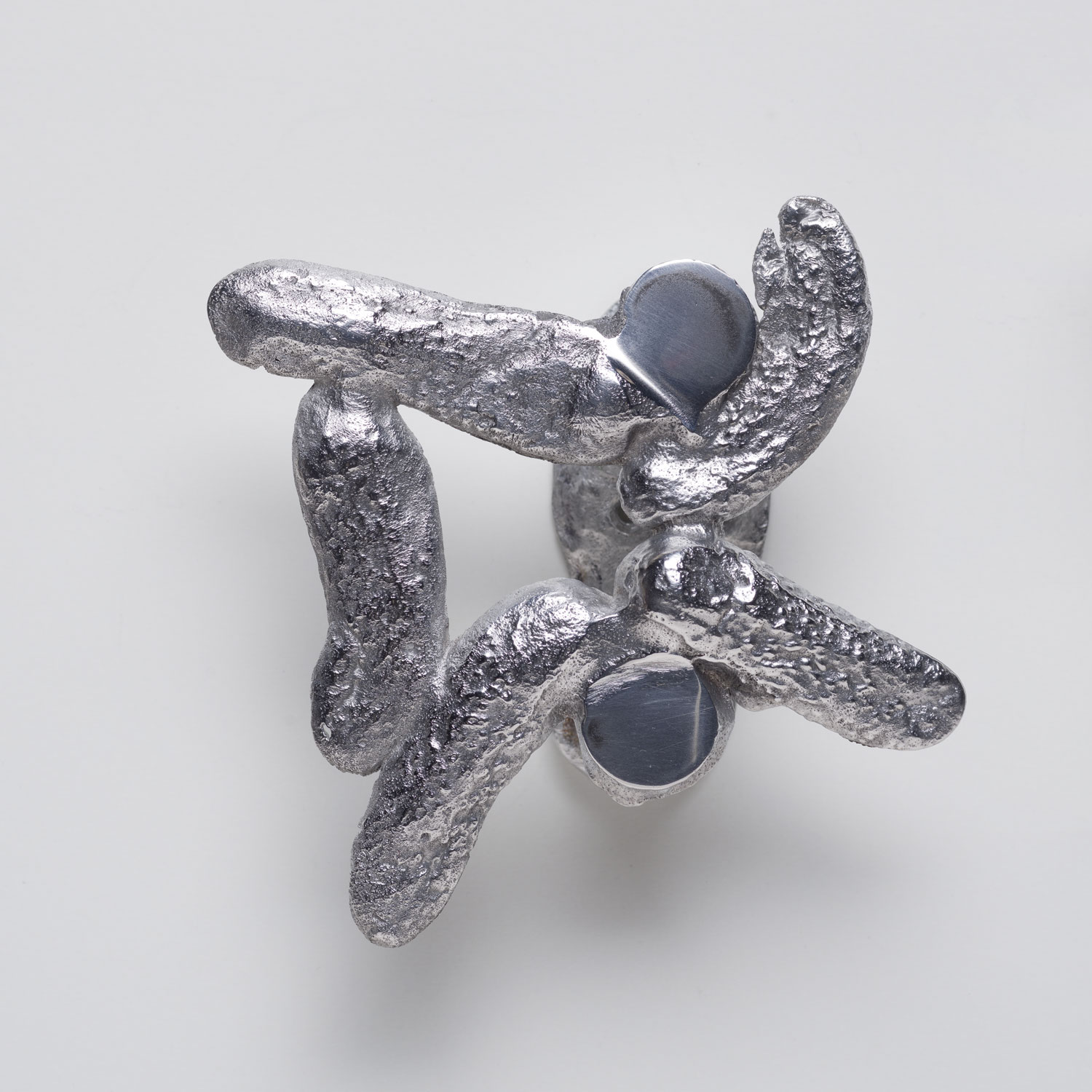
Måns Wrange
Born 1961
“Monument (version 2)”, 1993
“Monument” features a modified version of the classic Swedish coffee set Blå Blom by Gustavsberg. Coffee is poured from the pot into cups, but they soon overflow and the liquid runs into a container. A pump returns the coffee to the pot, whereupon the procedure starts over, in an eternal cycle. This work is part of “The History of Goodness”, which Måns Wrange worked on in 1991–1999. It explored the 1930s dream of the welfare state, where the home came to symbolise the good society. Rationalisations of everyday life through studies, norms and the introduction of standards, were made to foster good citizens with the aid of politics, but also aesthetics.
The artwork is not on display due to technical reasons.
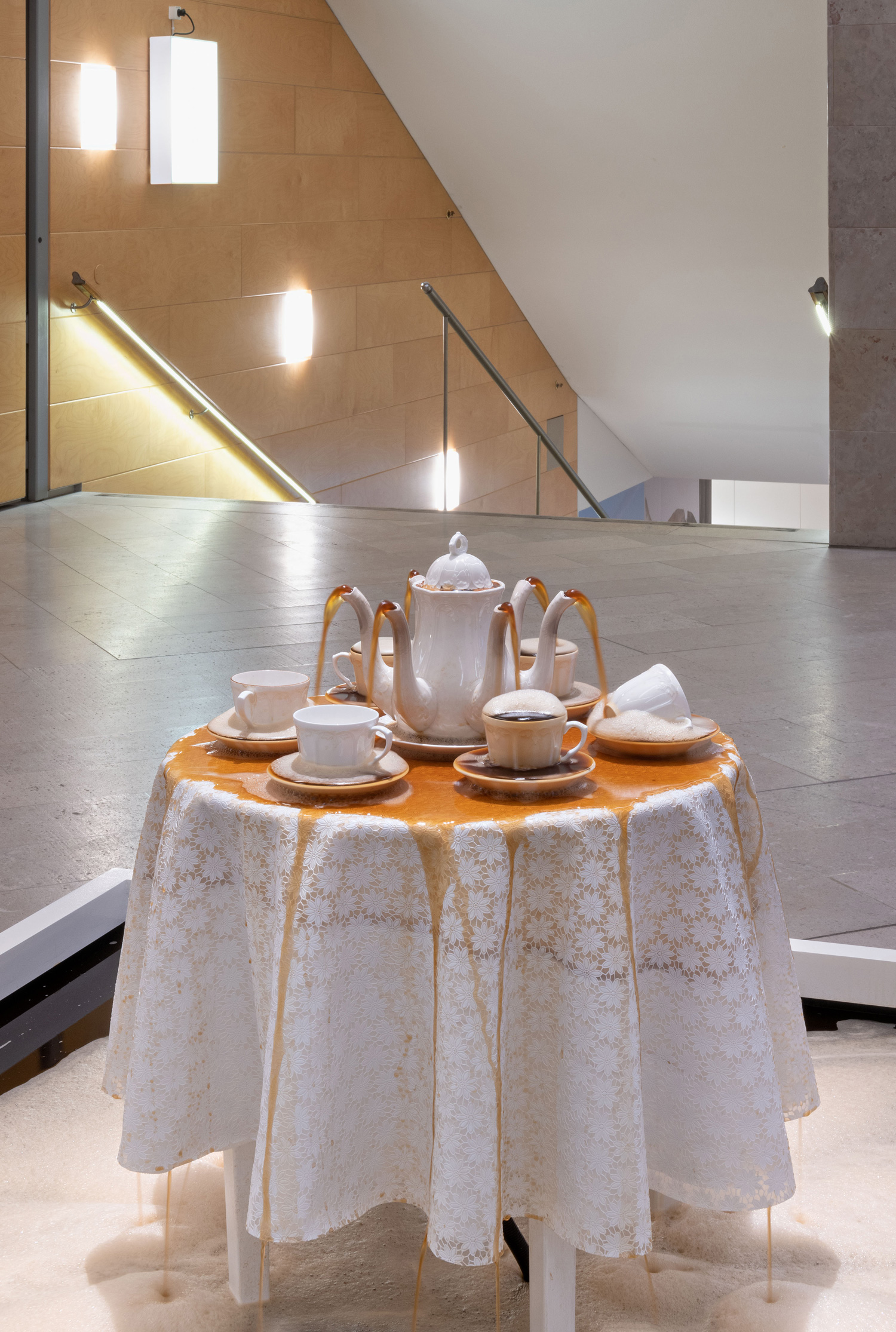
Olof Inger
Born 1979
“Connection”, 2019
The outlines of bodies are stacked on each other in the large collage “Connection”. The work is hung by steel chains and consists of recycled exercise equipment from the world of martial arts: punching bags, pads and mitts – materials used to practise hitting and kicking. The texture shows wear and tear from human bodies in explosive action. The coarsely stitched vinyl pieces are partly from protective gear that has absorbed the energy of blows given and received. In martial arts, all the senses are alert. Body and mind are focused on interaction when meeting a combatant. Olof Inger has been an MMA fighter, and in his art he converts the techniques used in martial arts into expressive gestures.
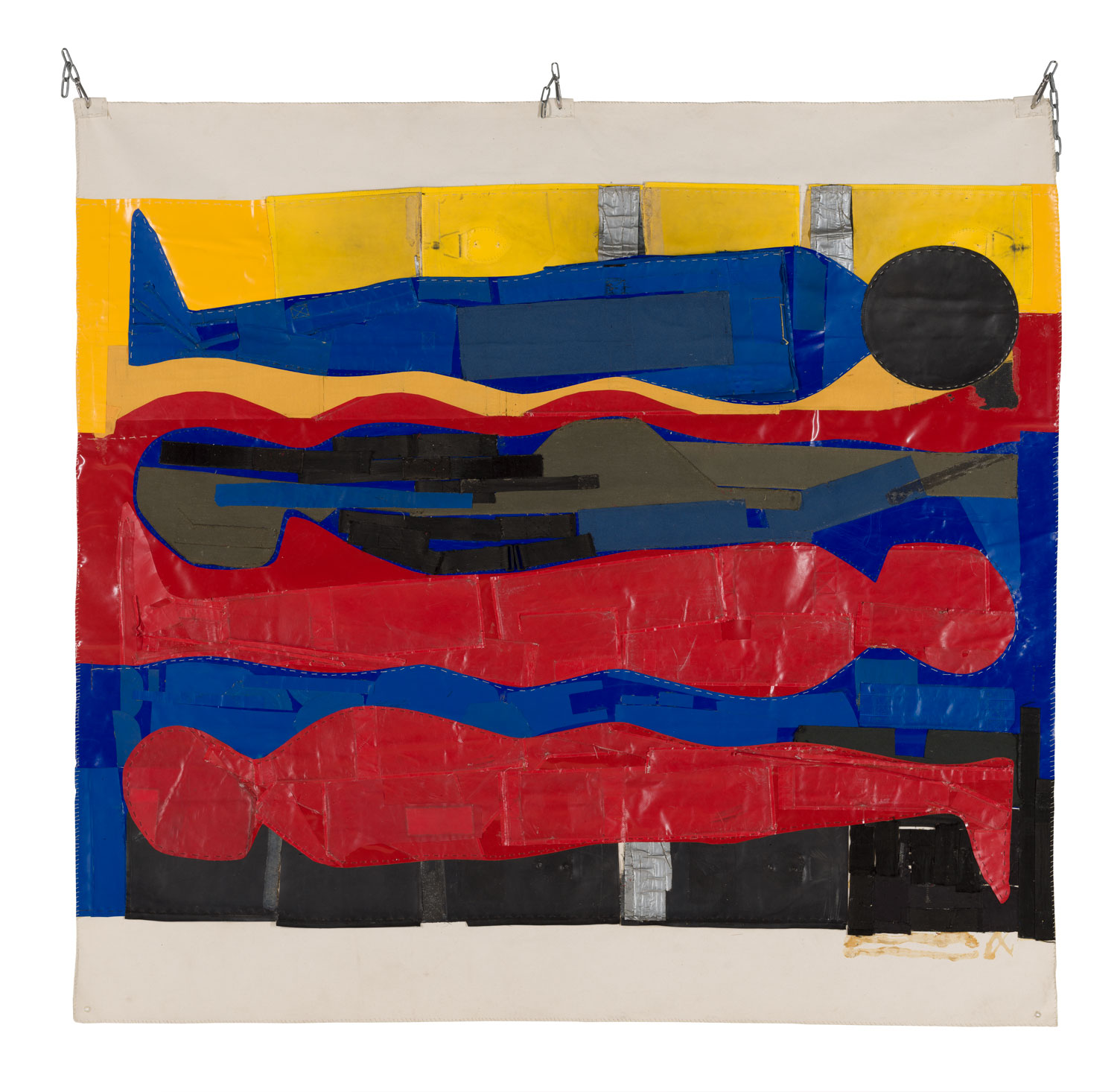
Signe Johannessen
Born 1978
“Puppy Play”, 2020
How do community, safety and family ties arise? What is the significance of the animal nature within us, and the threat of the unknown? In “Puppy Play” we observe a group of children of various ages dressed in furs, moving through a forest landscape. They are licking each other, fooling and tumbling around. Later on they arrive at a clearing shrouded in mist. It has become darker and we are slightly further away, as if we were hiding in the bushes surrounding the clearing. The atmosphere quickly changes from a playful togetherness to an uncanny feeling that there is something threatening the small group of children. Signe Johannessen works with film and sculpture. She repeatedly explores power structures and what non-human animal species can tell us about ourselves. Puppy Play came about after two unexpected events related to motherhood that Johannessen and her dog experienced together.
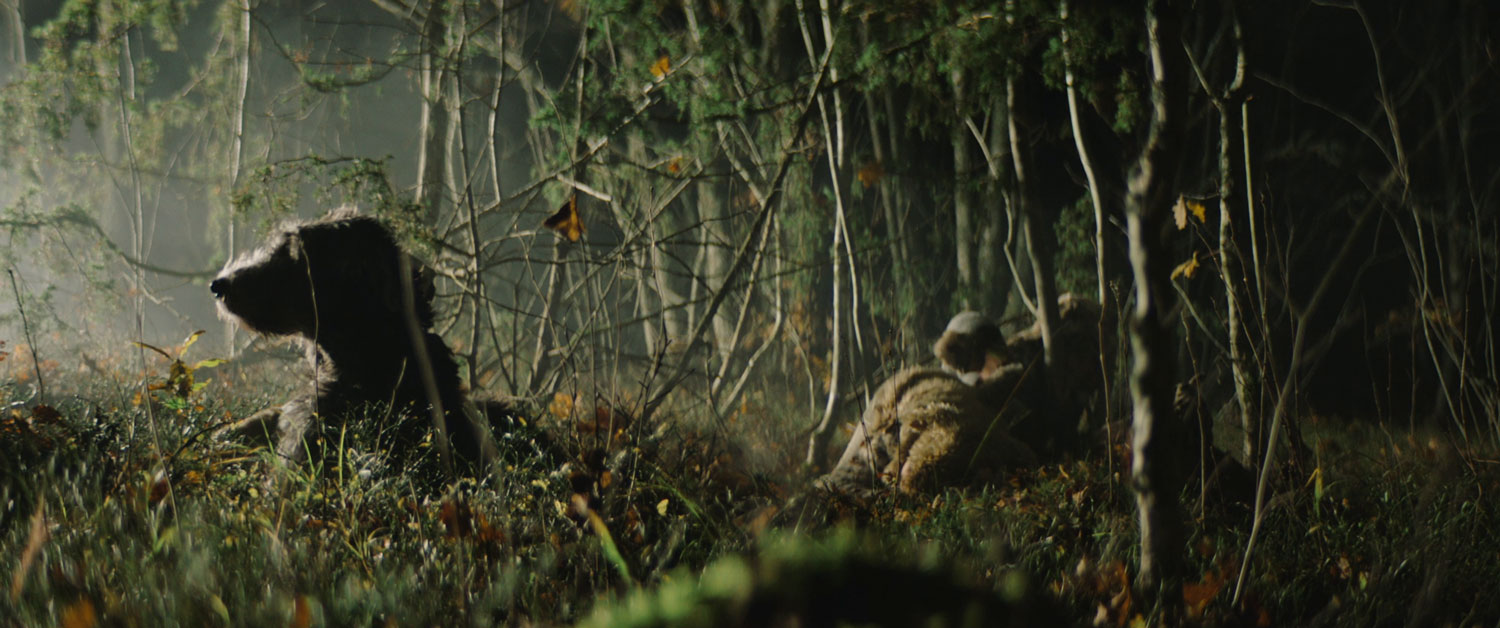
Trinidad Carrillo
Born 1975
“Birding”. From the Series No Date, 2015; “Brugmansia suaveolens, Betania, Pucallpa”, 2018
In the ongoing “Braiding” project the photographer Trinidad Carrillo reflects on her experience of living and working in both Peru and Sweden. She uses this rich material to compile books and create new collections of images, in large, vibrant colour photographs, often in quadrant formats. All her works have an undercurrent of magic. In a garden outside Lima, Carrillo has photographed holy trees and plants that were used in ritual contexts. Searching for mythical settings, she leads us through her personal works into other worlds. She appears in person in some of the images, along with her daughter, family and friends, and all the motifs have elements that render them both ordinary and dreamlike.
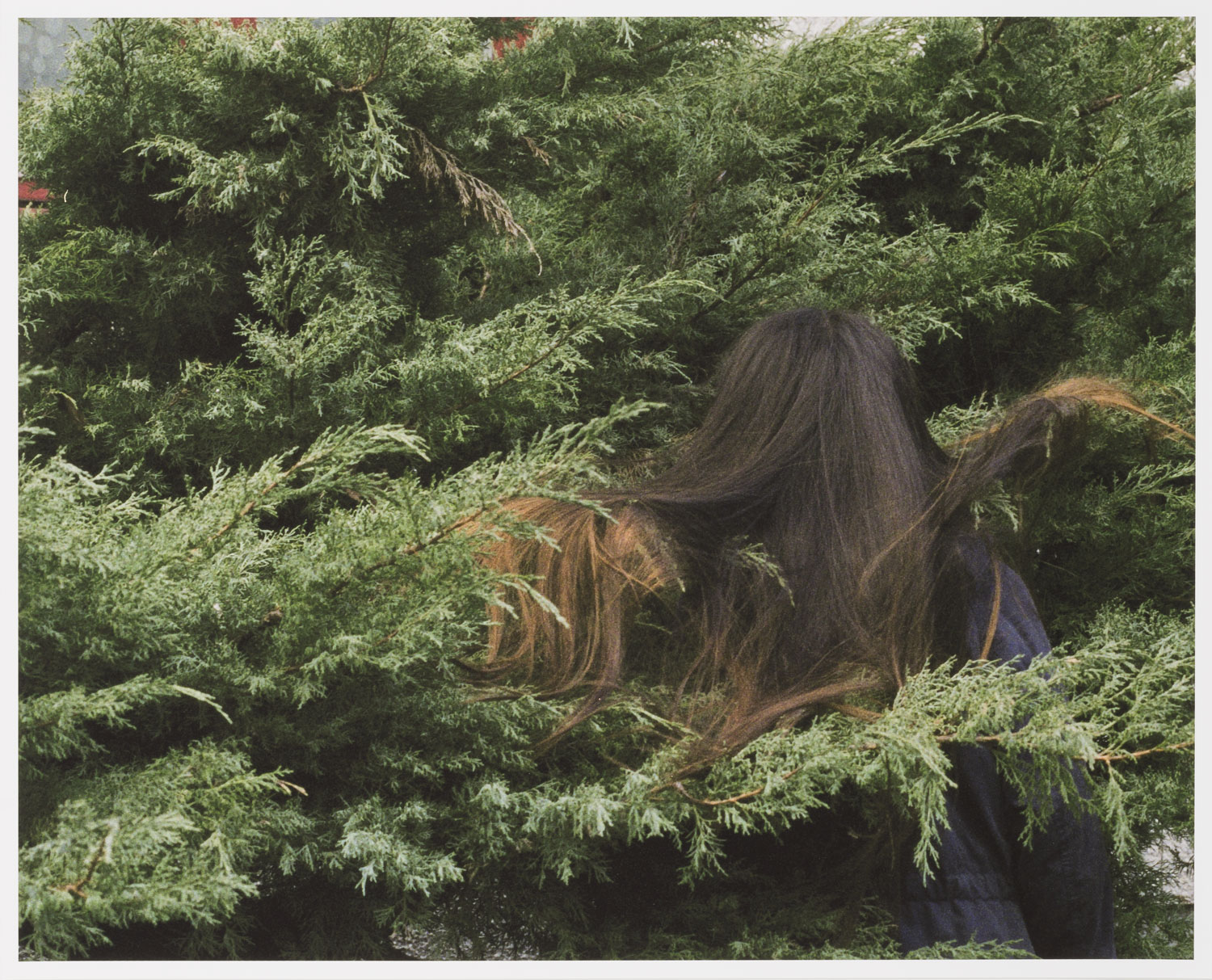
Ulrik Samuelson
Born 1935
The Henides, 2019–2020
Eight golden pillars or columns against a dramatic landscape in black and red. Not straight but tottering, slightly fragmented. Rooted neither at the base nor holding up a ceiling or architrave of the kind seen in ancient Greek temples. They appear like the sentinels of an earlier civilisation, preventing our gaze from penetrating further into the landscape. Ulrik Samuelson’s painterly practice is in dialogue with both his own earlier works and art history. The columns, the black paint and the gold also feature in his artistic design for the Kungsträdgården underground station. Associations bounce as if in an echo chamber: abstract art, Nordic romantic landscape painting, abstract expressionism and Marcel Duchamp..
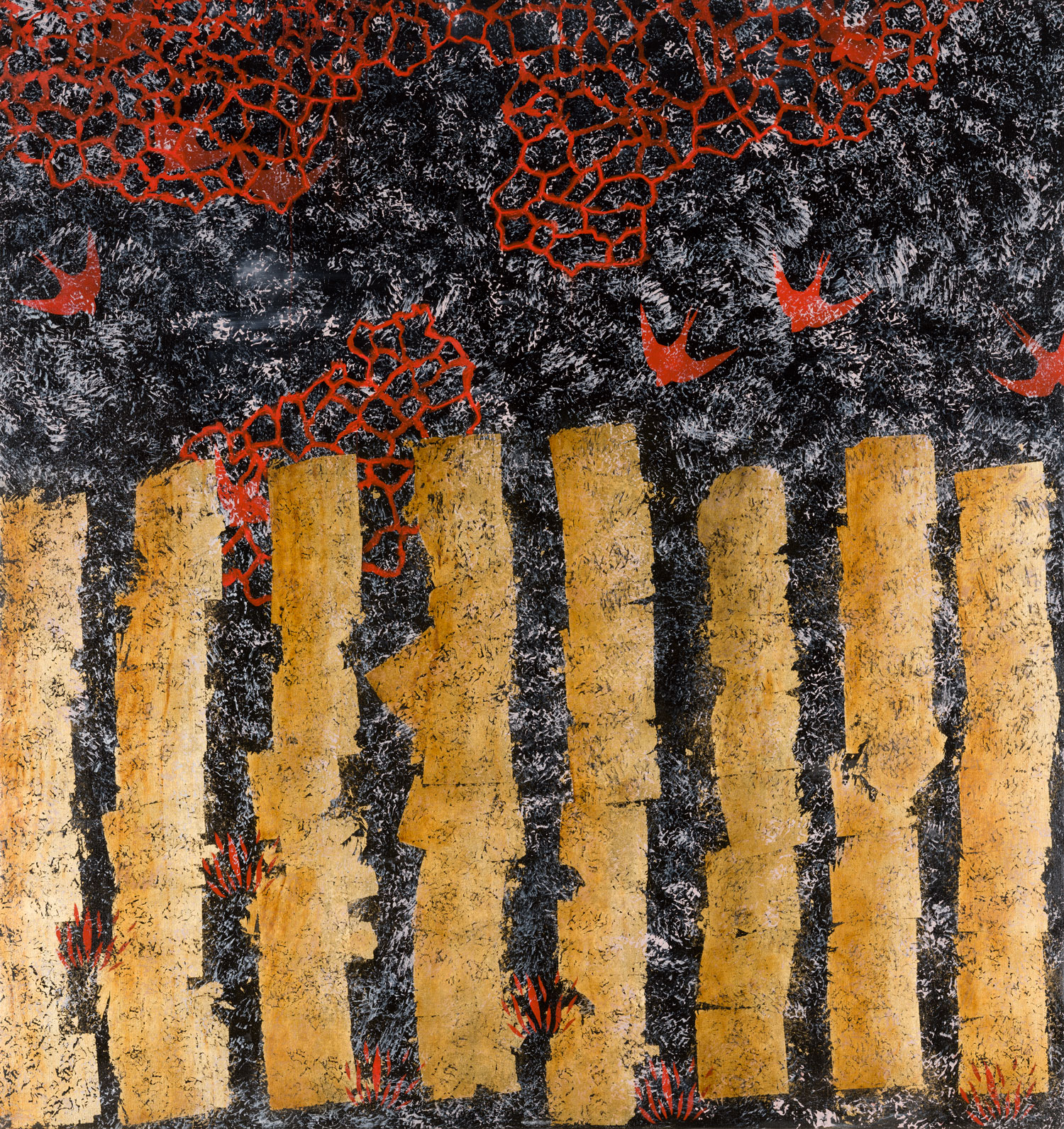
Valeria Montti Colque
Born 1978
“Apú Mamáhöjden Ojitos de Sal”, 2021
Jokerita is sleeping within Mount Apú Mamá Ojitos de Sal. She has been longing for a home. The work of Valeria Montti Colque is a collage of myths, geography, imagination and autobiography. Apù means mountain in the Quechuan languages. In Andean beliefs mountains are considered to be ancestors that surround and implant us with a sense of belonging. They should be treated as relatives. Growing up far away from her roots has inspired Montti Colque to build her own mountain, together with her family and friends. The work is a physical act that connects distant places. Montti Colque is able to wear the beings that inhabit the mountain, they are all part of her and have been used in her performance.
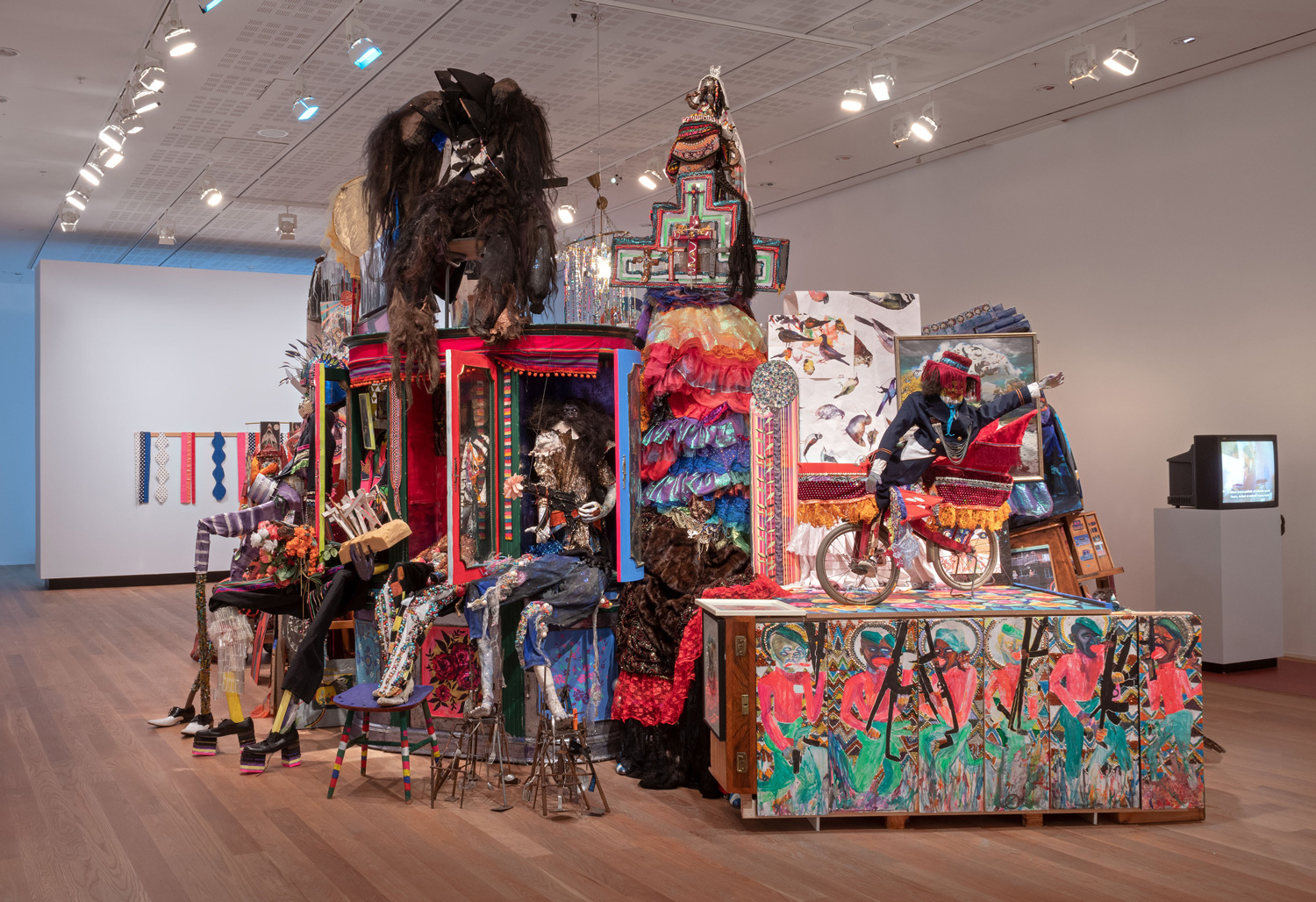
Åsa Norberg & Jennie Sundén
Born 1977
“Cosmic Latte”, 2020
The discovery that the universe is a beigeish-white colour was made by a team of researchers in 2001. The colour was named “cosmic latte”. In the installation of the same name and shade, Åsa Norberg and Jennie Sundén demonstrate their in-depth research into the history of milk. Among the wallpaper’s many images, separated by canals of milk ducts, like those inside a lactating mother’s breast, we find images of Tetra Paks, as well as references to Cleopatra’s donkey milk baths and the Suffragettes’ fight for animal rights. One unsuccessful chapter in the history of milk was Mussolini’s business idea of replacing wool with milk fibre, a fibre that the installation’s embroideries are made from. Four sculptures, which play with the imagery of Futurism and its passion for the industrial by picking up on the clinical materials used in pasteurisation, are also part of the complete work. Each element of the installation forms part of a milky way of associations and meanings.
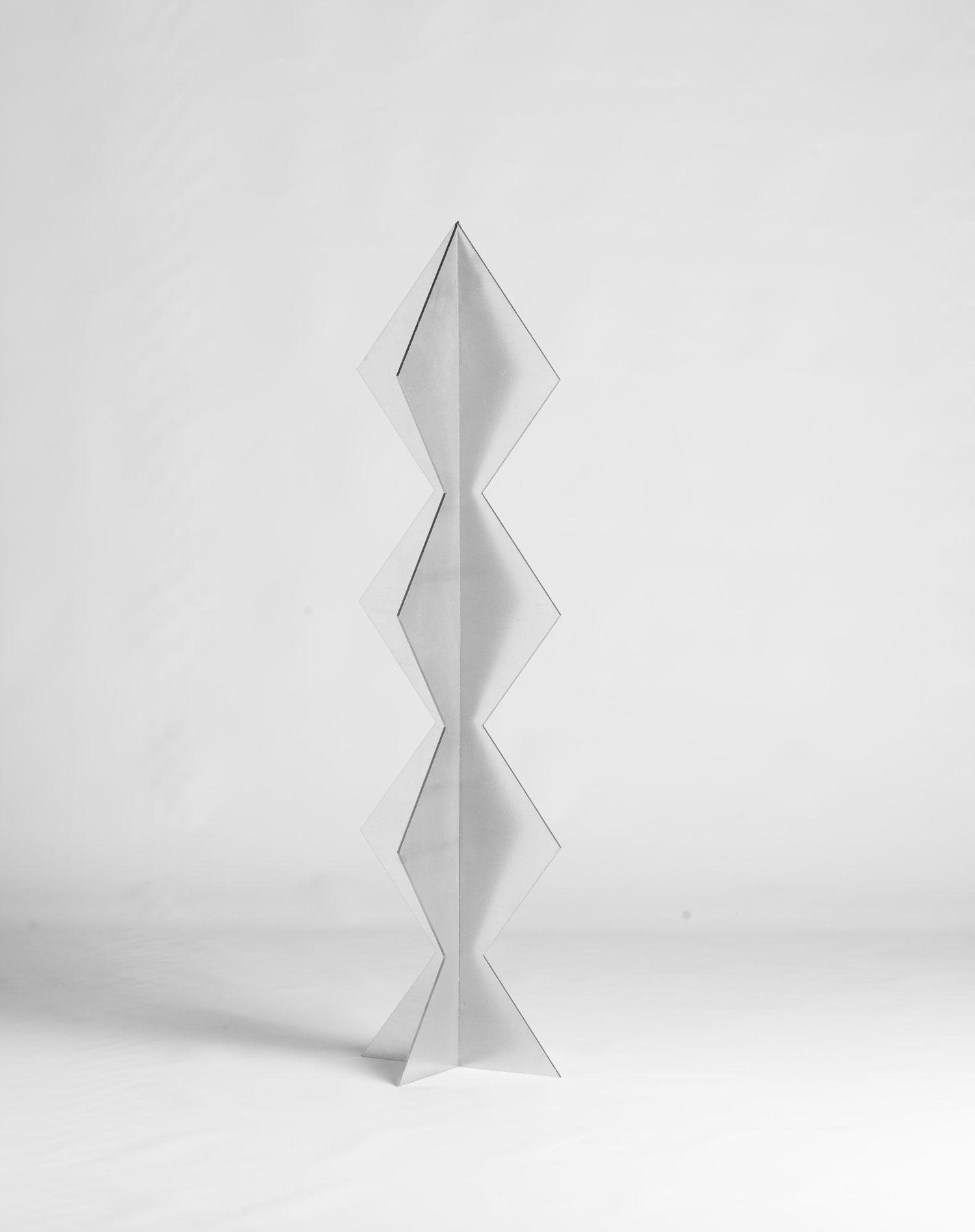
Svenska förvärv
I grupputställningen ”Svenska förvärv: Tändstickor” möter du ett 40-tal konstverk som under förra året köptes in till Moderna Museets …
Tändstickor
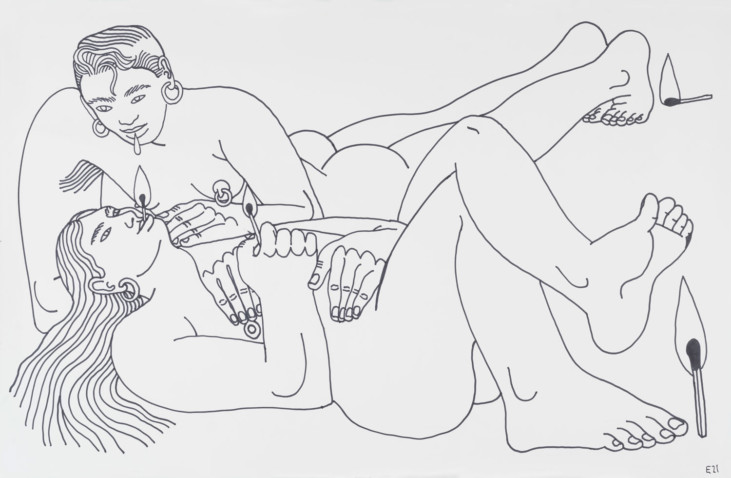
Svenska förvärv 2021 färdigställt
2021 tilldelades Moderna Museet 25 miljoner kronor extra av regeringen för inköp av konst för att stödja det svenska konstlivet under …
Svenska förvärv 2021 färdigställt
